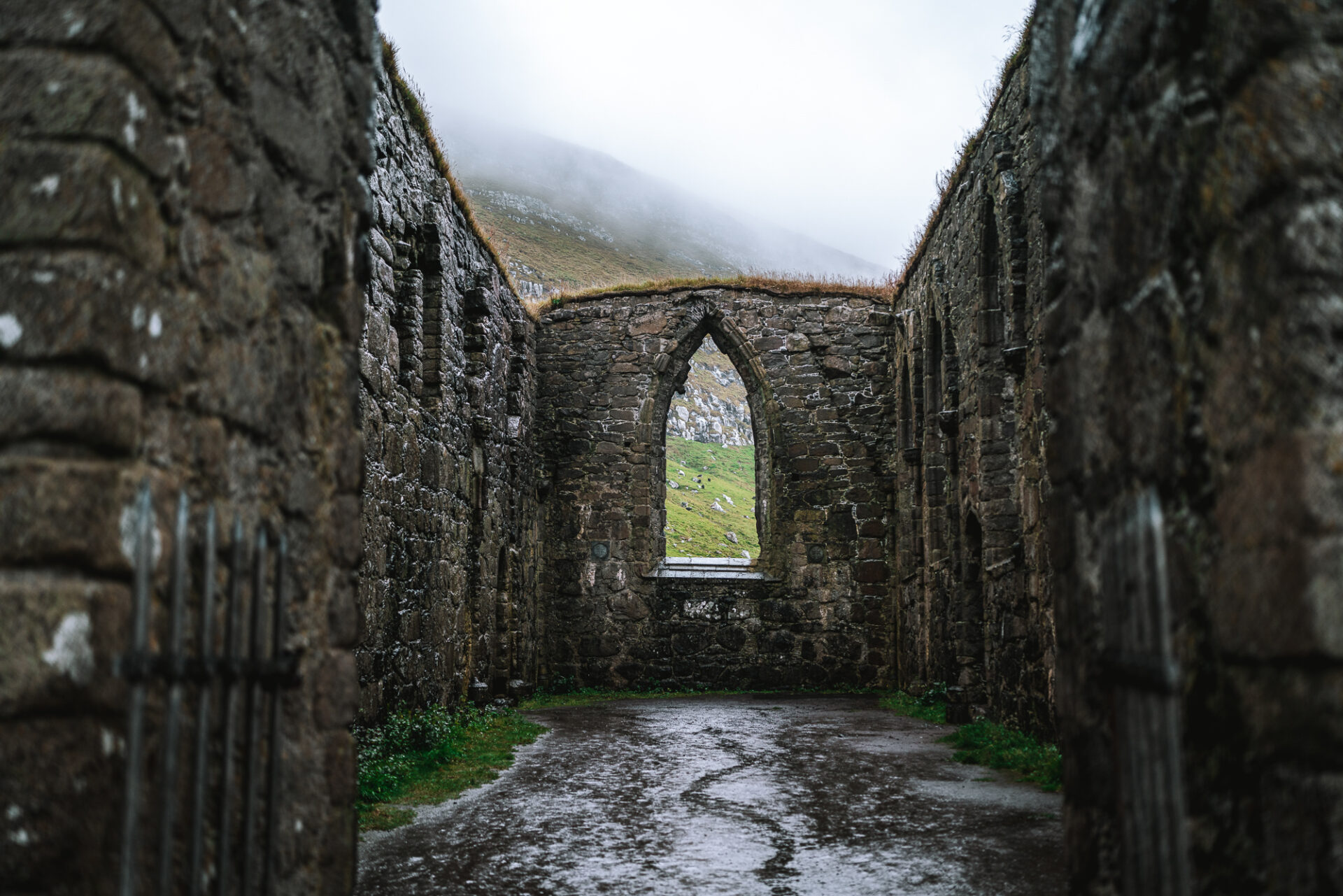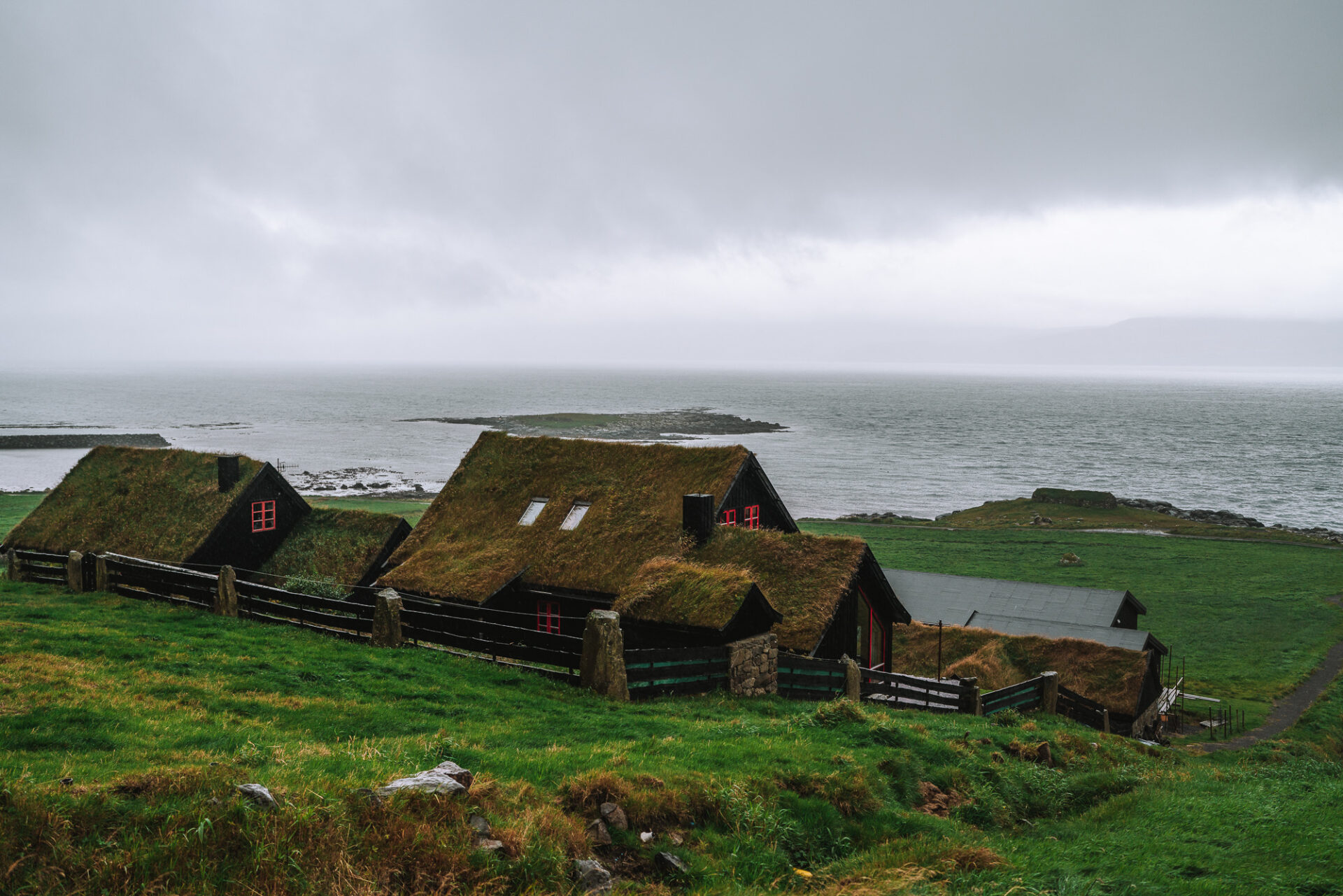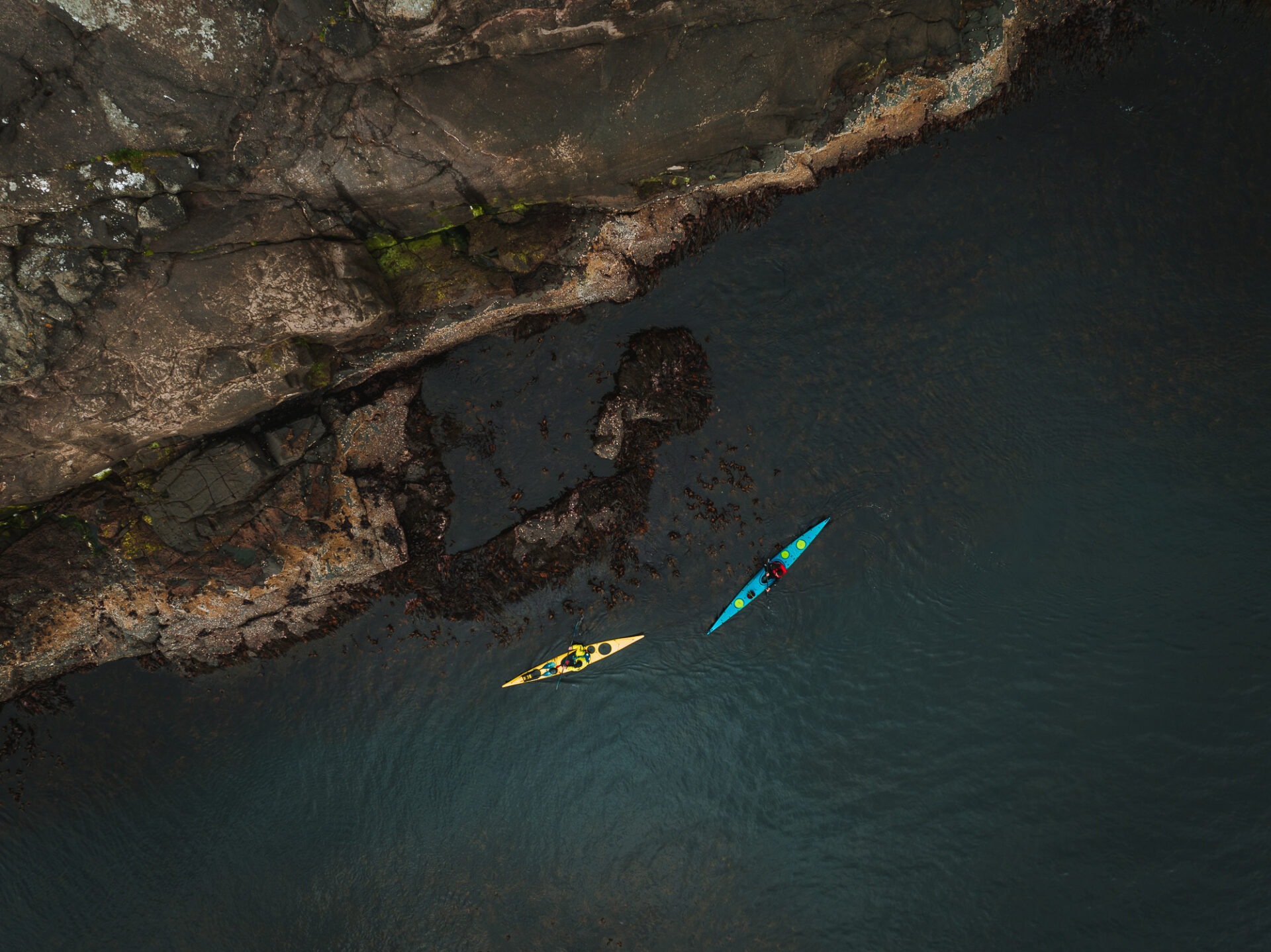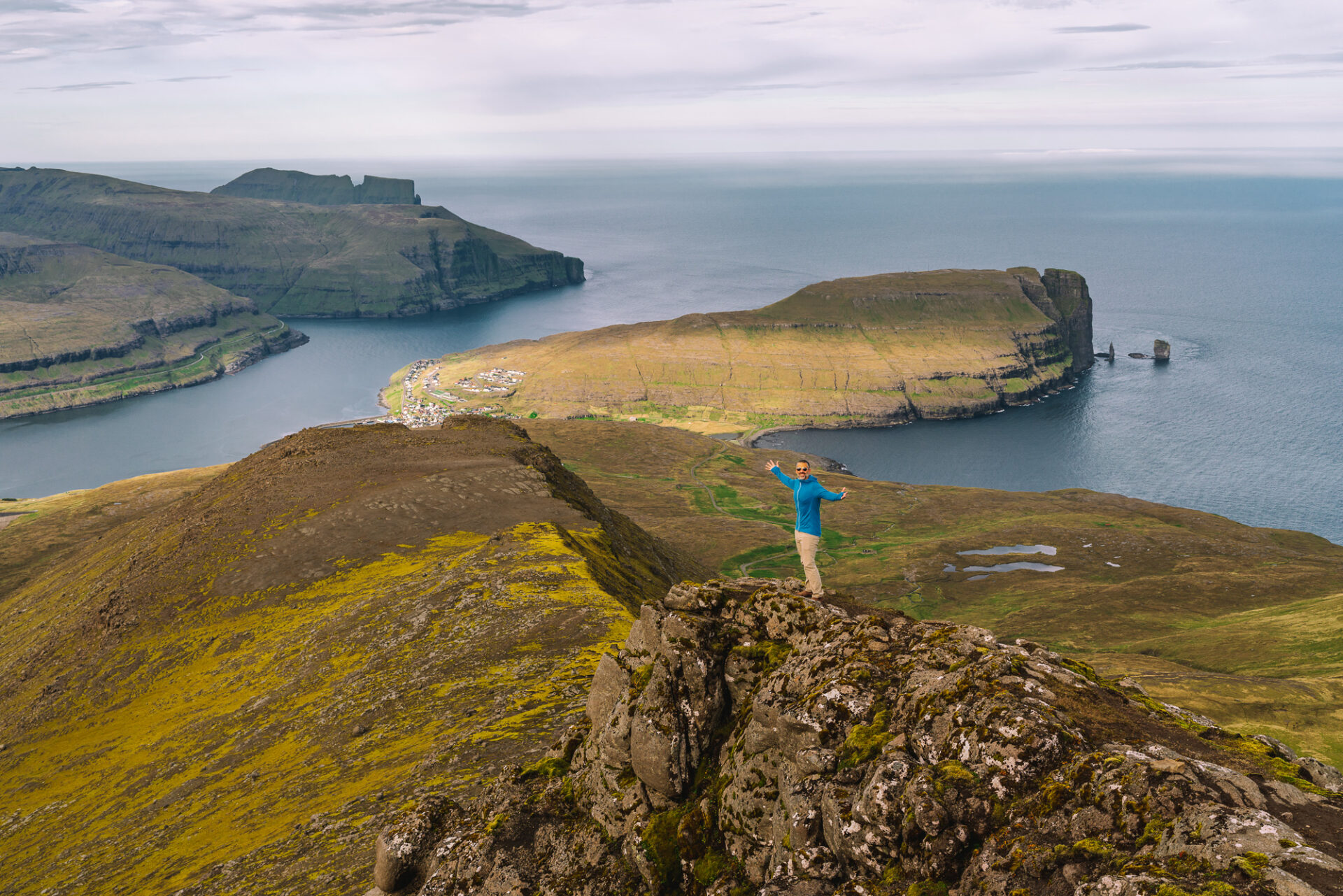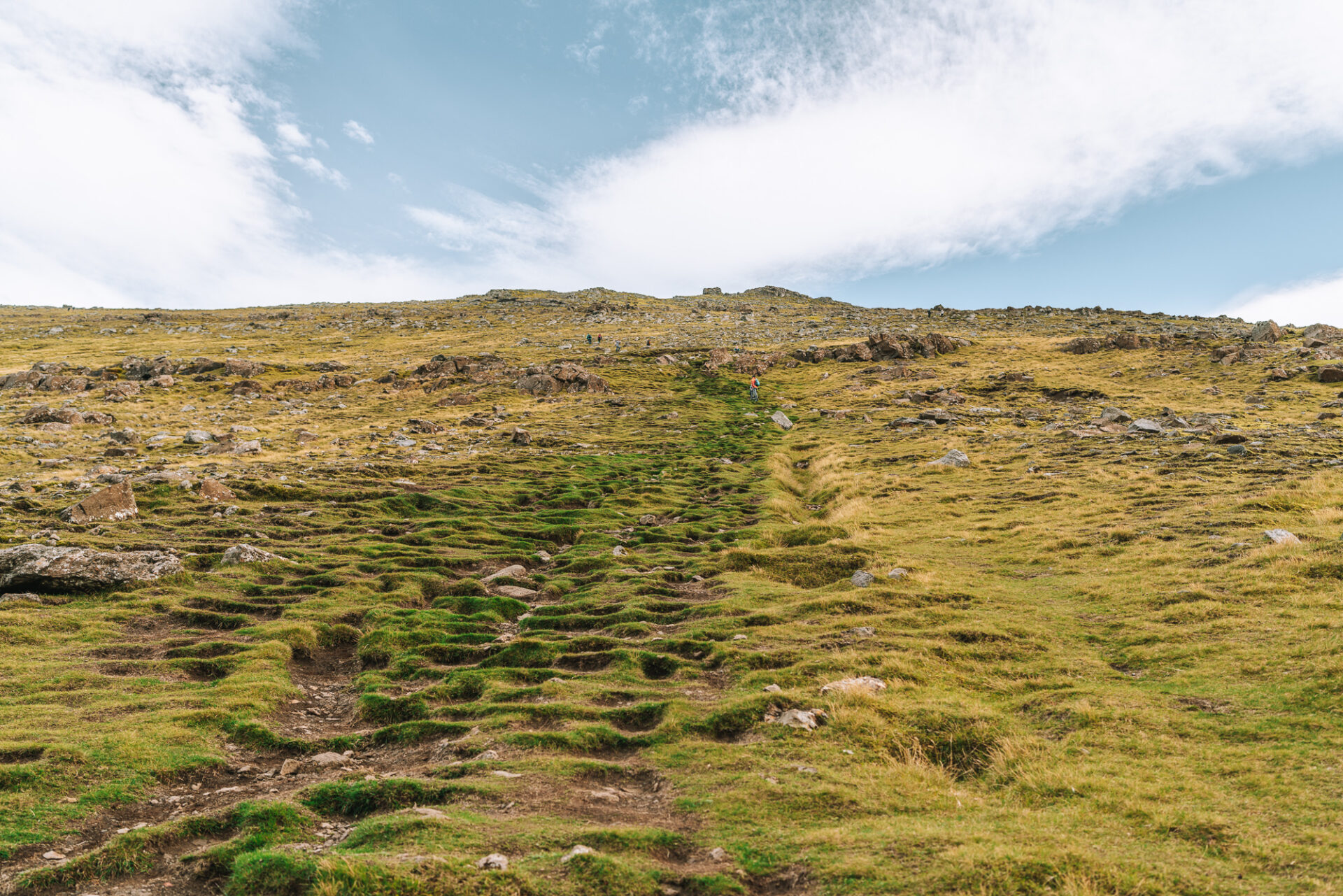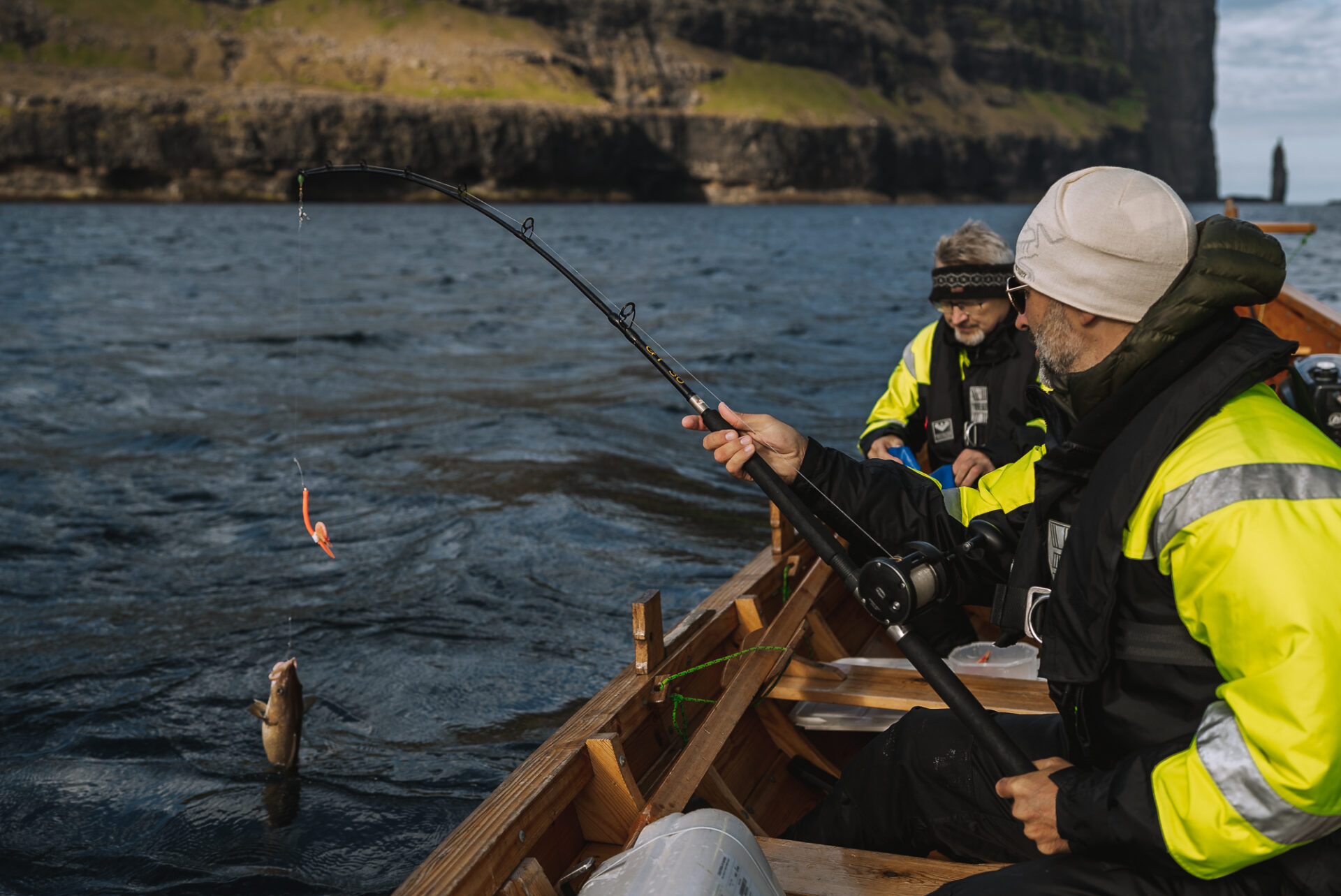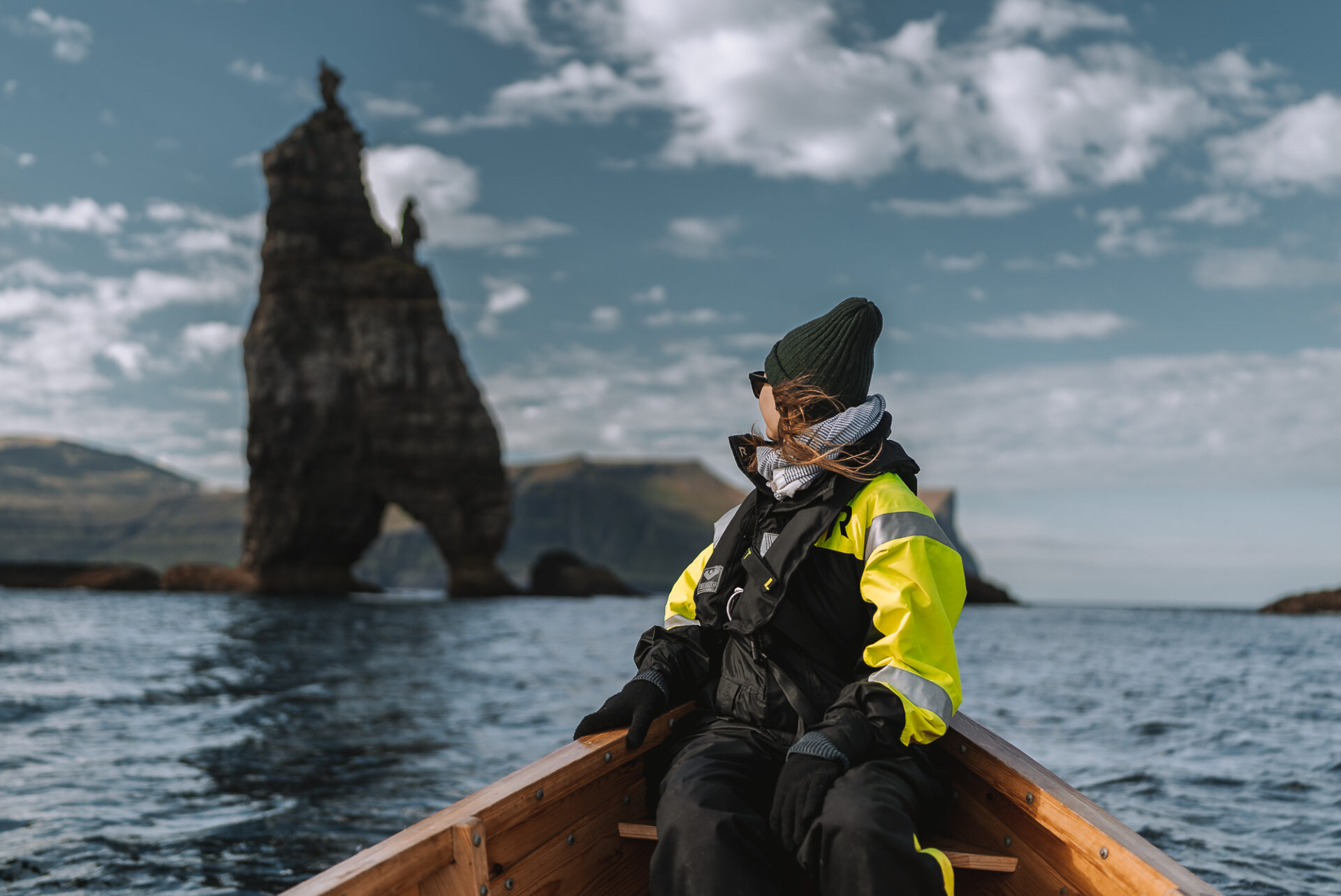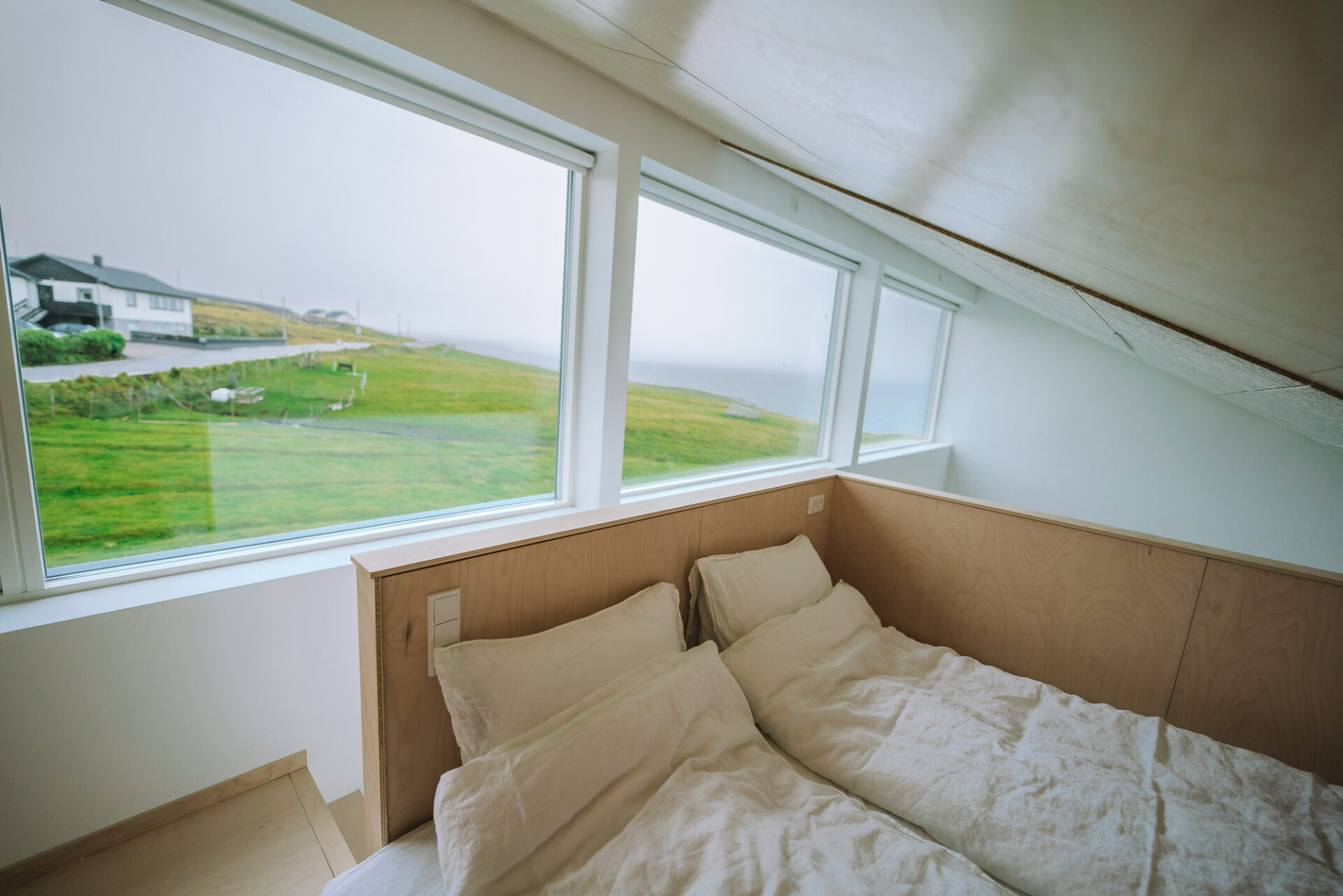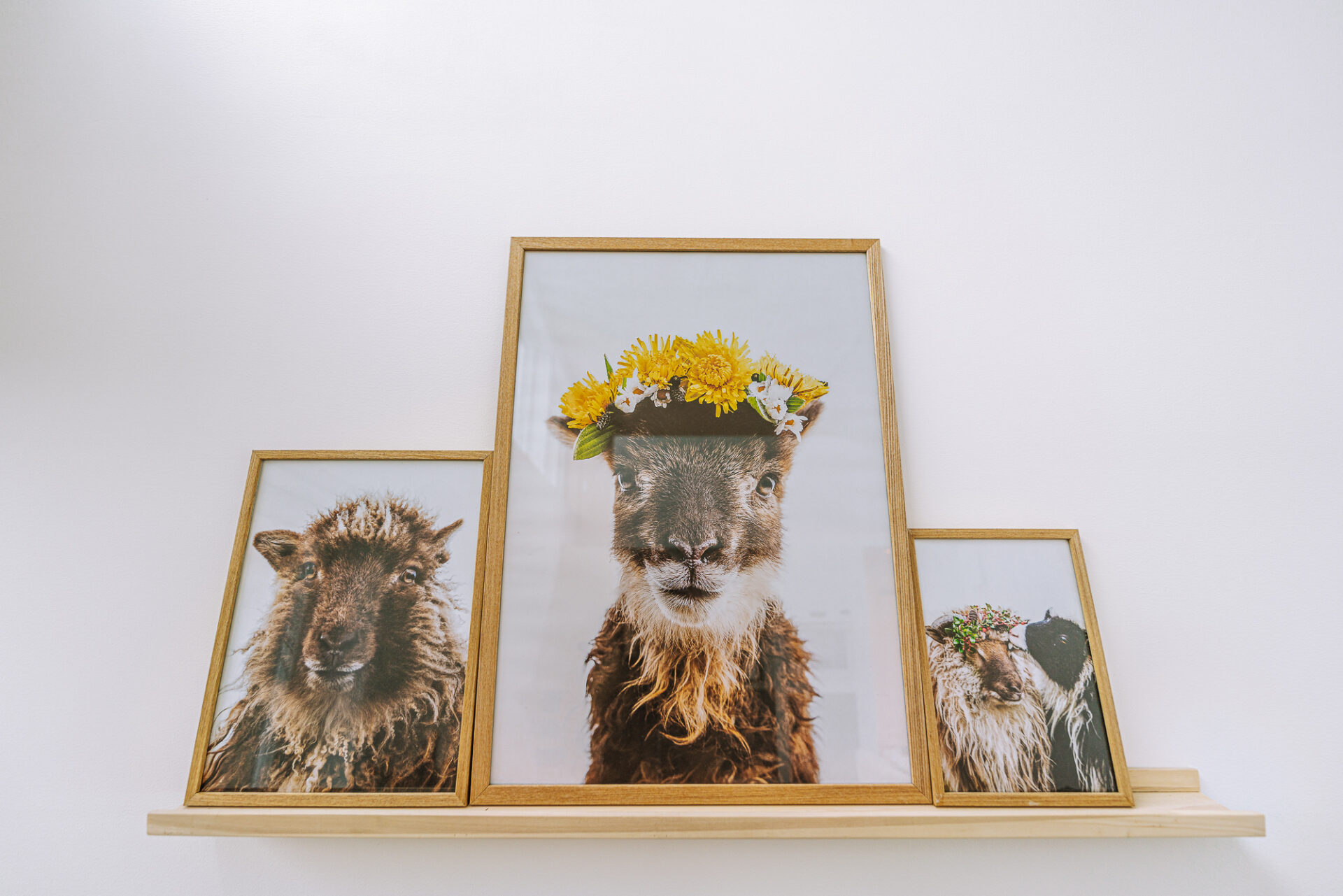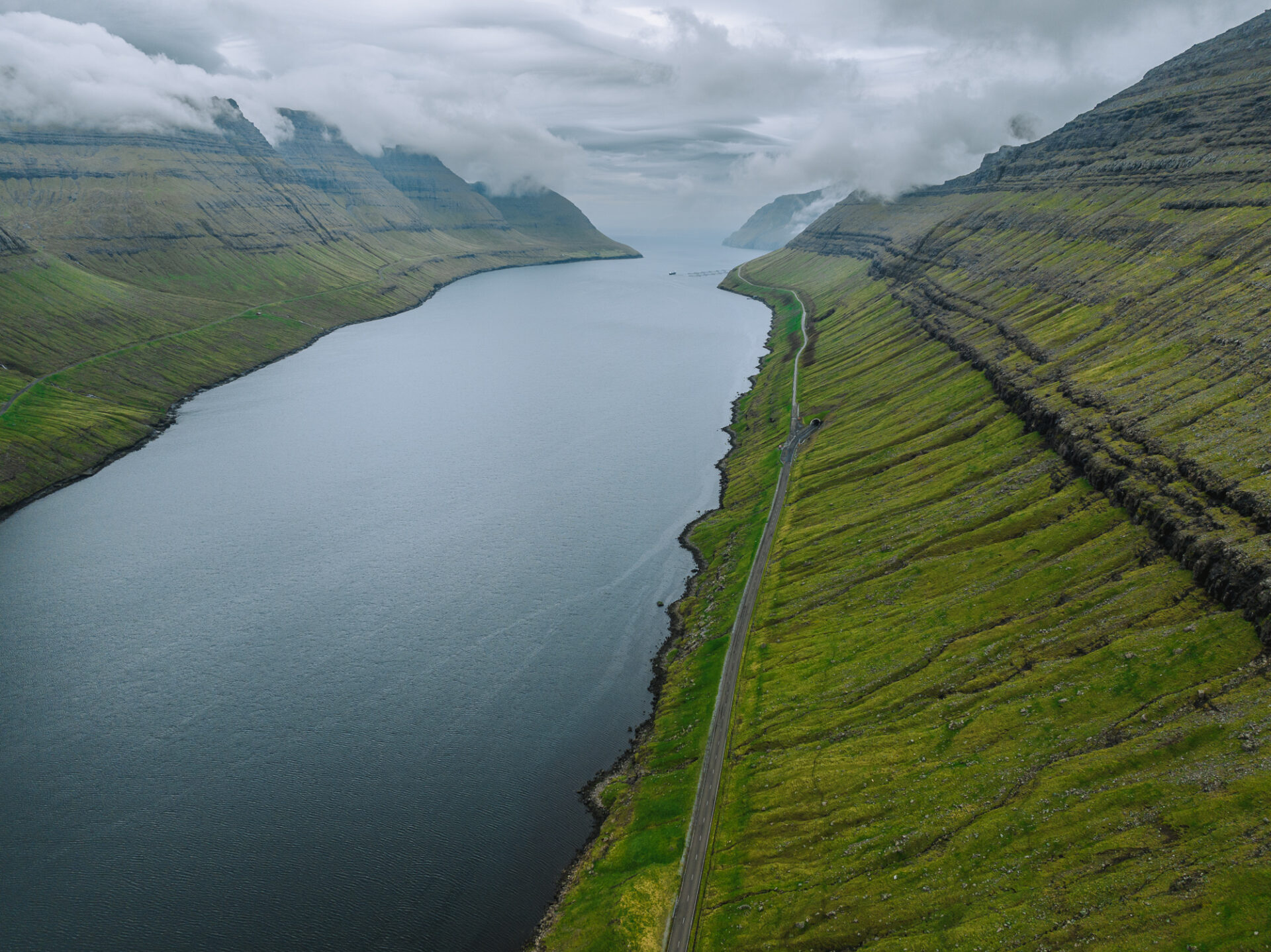A small archipelago and island country located in the North Atlantic Ocean, the Faroe Islands is a land of mystery and legends. With their towering cliffs and green hillsides, endless lakes, and steep mountains sides, these remote islands feel like a land of giants. They serves as a humble reminder of the tiny place we occupy in the world. If you are looking for best things to do in Faroe Islands, buckle up! We’ve got all the info for you in this comprehensive guide!
*This post may contain affiliate links, as a result, we may receive a small commission (at no extra cost to you) on any bookings/purchases you make through the links in this post. As an Amazon Associate, we earn from qualifying purchases. Read our full disclosure
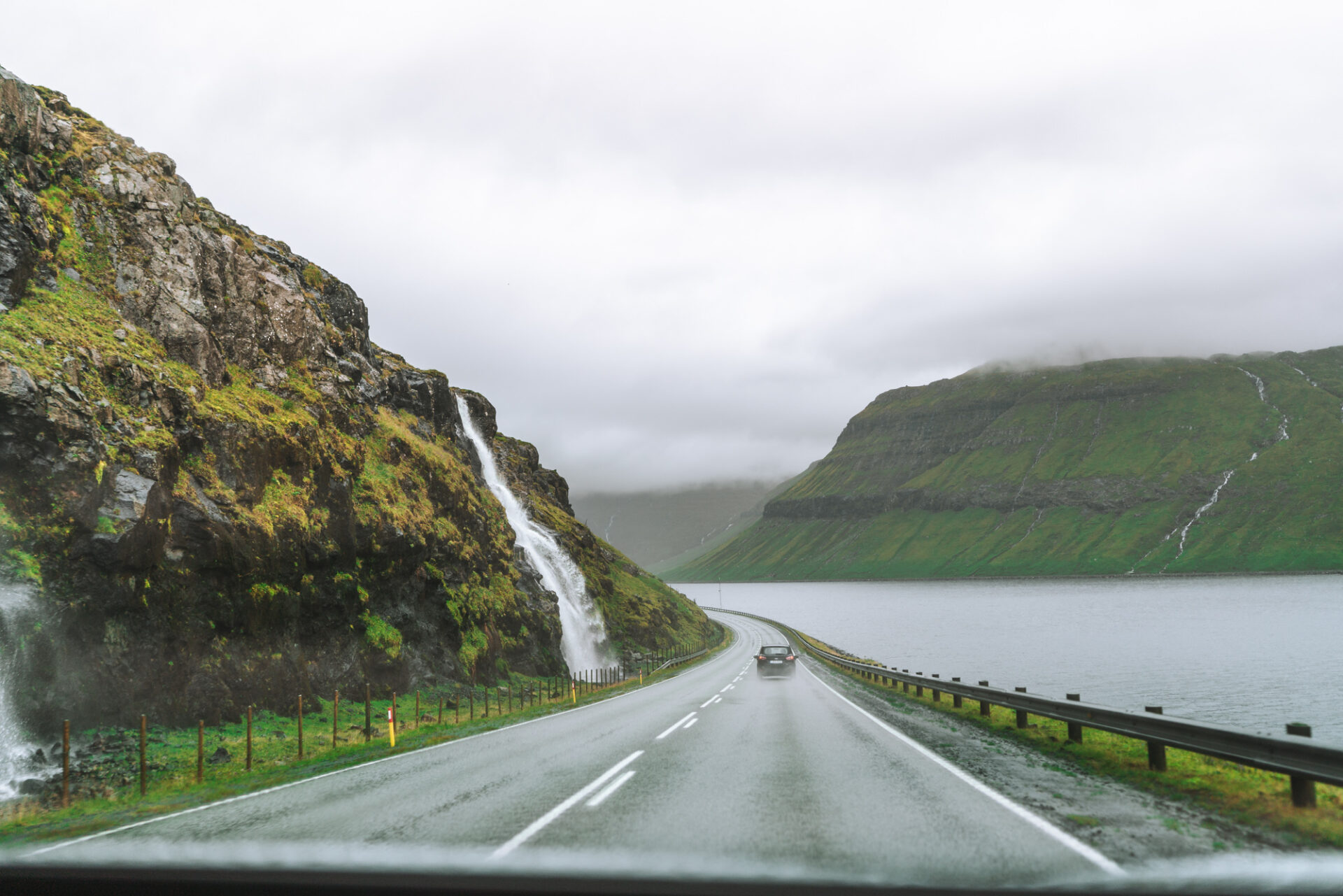
Traveling Soon? Here is a list of our favourite travel providers and accessories to help get you ready for your upcoming trip!
About the Faroe Islands
The Faroe Islands consist of 18 islands and more than 750 islets located halfway between Norway and Iceland. The islands are under the sovereignty of Denmark, though they have their own government and parliament. The Faroese self-government was granted in 1948, though Denmark still retains control of the defence and foreign affairs.
With a population of just over 50,000 people, the islands are one of the most sparsely populated places in Europe. The majority of the population is concentrated on the main island of Streymoy, with many living in and around Torshavn, the capital of the Faroe Islands. The islanders are descended from Vikings, and the Faroese language is closely related to Icelandic and Old Norse.
Despite their small size, the Faroe Islands have a rich history and culture. The Faroe Islands are home to hearty and determined people who have made the most of their remote and rugged environment. Living off the land and the sea, the Faroese cherish a strong sense of community and tradition – a belief that reverberates through their daily lives.
What the Faroes lack in human population, they make up in their population of sheep. In fact, there are about 80,000 sheep on the islands that play an essential role in the Faroese lifestyle and economy. The sheep are well-adapted to the harsh conditions of the islands and are used for their meat, milk, and wool. They are incredibly agile, able to scale steep cliffs and navigate narrow ledges with ease and are found roaming free all around the islands.
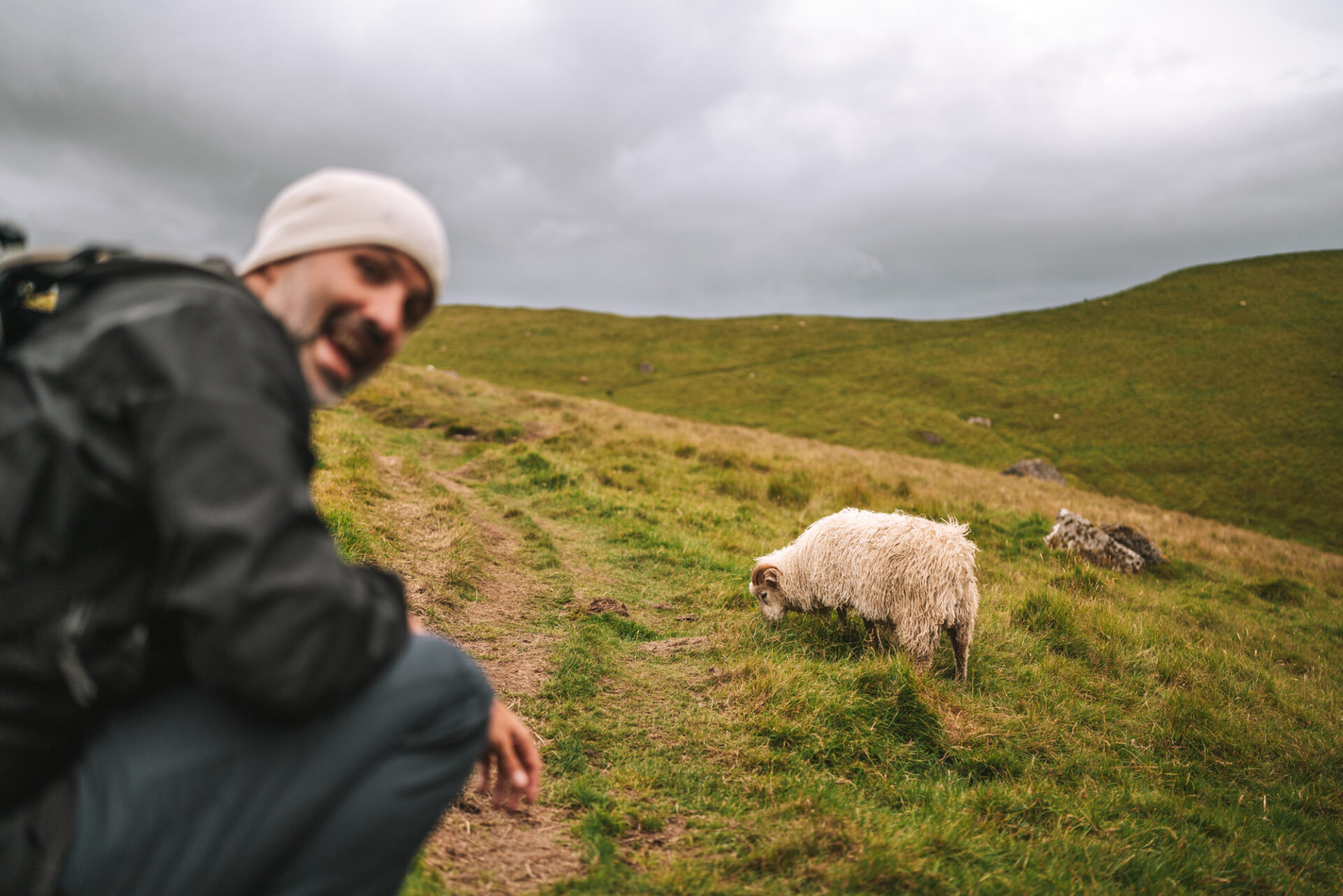
Best Time to Visit Faroe Islands
The Faroe Islands are known for their unpredictable weather. One moment it might be sunny and the next, it might be pouring rain. Many of our mornings in the Faroe Islands started out in complete fog, only to develop into a beautiful sunny day and a rainy evening.
The general climate is mild, with cool summers and mild winters.
In the Winter, it is not unusual for there to be strong winds and heavy rain, followed by a period of calm. The climate in the winter makes visiting Faroe Islands a tough sell, but the opportunity to see Northern Lights may lure in some adventurous travelers.
The weather in the Spring is usually more pleasant, with mild temperatures and longer days. However, snow is still quite common in March and while the chances of snow decrease as Spring settles in, it’s not uncommon to see snow in April and even in May.
The summer months, from June to August, is the most popular time to visit the Faroe Islands. This is when the weather is usually at its best, with highs ranging from 60-70 degrees Fahrenheit (15-21 degrees Celsius). These are also the driest months in the Faroe Islands.
Summer also offers the benefit of lots and lots of daylight! At midsummer in mid-June, the sun never fully sets, allowing you to see more and do more during your time in the Faroe Islands.
Fall typically has the most stable weather, with mild temperatures and occasional showers. It is also very picturesque, with the vibrant colours of autumn covering grassy slopes.
For us, late summer/early fall – the months of August and September are some of the best months to visit the Faroe Islands as they offer an opportunity for sunny days and starry nights.
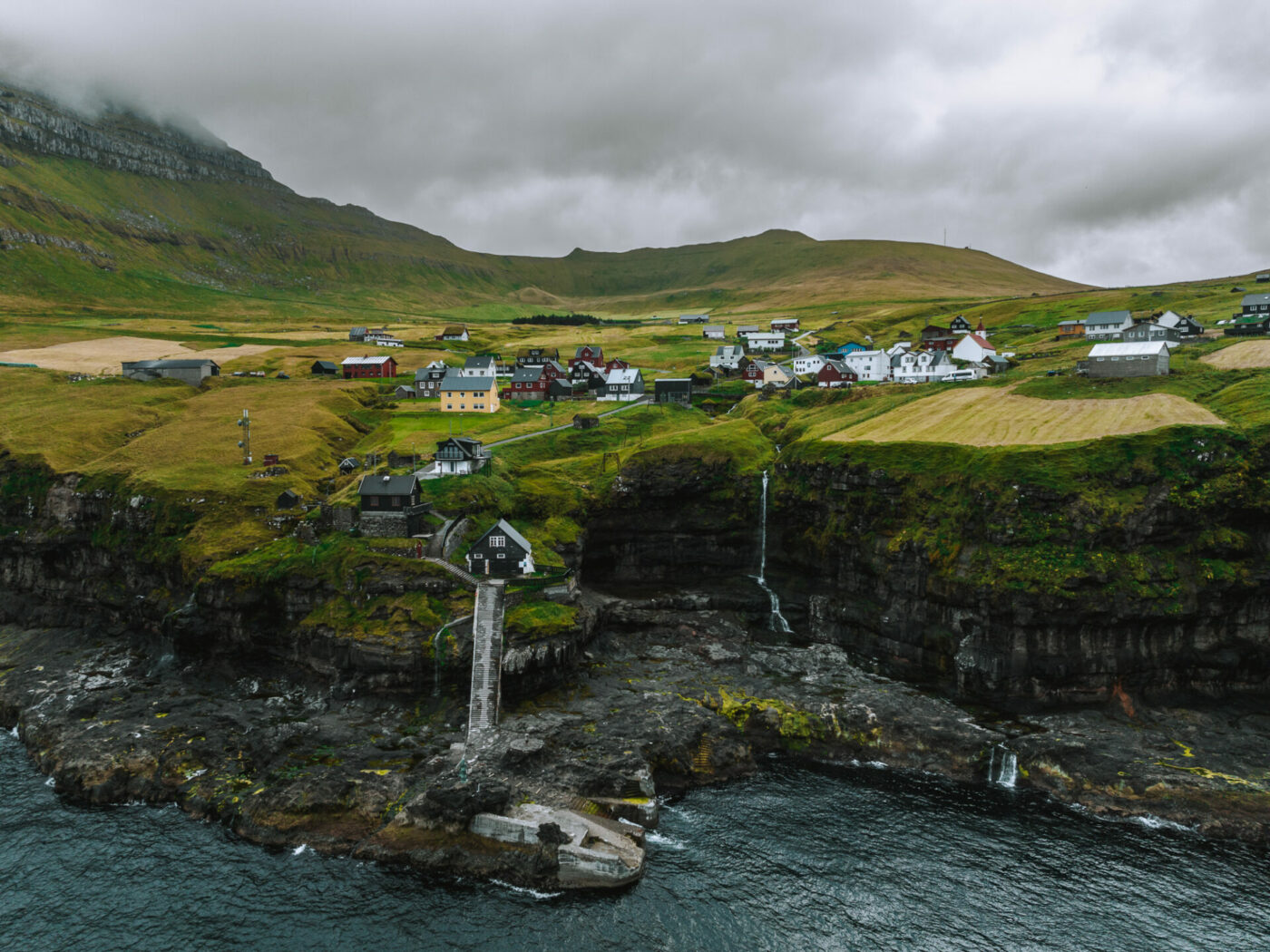
How to Get to the Faroe Islands
The best way to get to the islands is by air or by sea.
By Air: There are 3 airlines that fly to the Faroe Islands: Atlantic Airways, Scandinavian Airlines, and Widerøe AS. You can fly non-stop to the Faroe Islands from a variety of Nordic countries, such as Copenhagen (Denmark), Paris (France), Reykjavik (Iceland), Edinburgh (Scotland), Oslo (Norway), and Bergen (Norway). There are also seasonal flights from places like Barcelona, the Gran Canary Islands, and Mallorca. Flights range from 1-3 hours in length. Atlantic Airways flights are the most frequent and offer the best connections with a number of cities across Europe.
By Ferry: It is also possible to take a ferry from Denmark and Iceland with the Faroese company, Smyril Line. The journey by ferry takes between 24 and 36 hours but offers an opportunity to reduce your CO2 emissions compared to flying and enjoy a slower, more scenic way of traveling to the Faroe Islands. There are cabins on board as well as tons of facilities, including restaurants, shops, cinemas and even rooftop hot tubs!
Those coming from Europe, also have an opportunity to bring their own car or campervan, which makes it even easier to get around the Faroe Islands.
How to Get Around Faroe Islands
There is no better way to explore the Faroe Islands than by car. The islands are connected by an excellent infrastructure of roads, bridges and subsea tunnels.
We’ll even go as far as to say that driving around the Faroe Islands is an attraction in its own right! The roads wind through mountains and along the coastline, past waterfalls and through tunnels carved into the rock. There are plenty of places to stop and take in the views, or even go for a hike. And with so few cars on the road, you can really take your time and enjoy the journey.
Traveling with an Electric Car: The Faroe Islands are an ideal destination to explore with an electric vehicle, which is precisely what we did during our time on the islands. We rented a Volkswagen ID4 from Enterprise with pick up right from the airport. The rental price was around $100/day, just slightly higher than the price of a regular sedan, but it allowed us to explore the country with very little CO2 impact from driving.
Charging the vehicle was a breeze! The car had 400km range and given how small the Faroe Islands are, it allowed us to travel for days without any need to charge up.
When we did need to charge, we followed the, we were able to find our closest charging station on elbil.fo. There was a charging station conveniently located in a parking lot in Torshavn Old Town where we parked daily while exploring the town and going out for dinner. We would leave the car in the parking lot while eating dinner and come back to an almost fully charged vehicle. We never once had to alter our plans or wait anywhere to top up the charge!
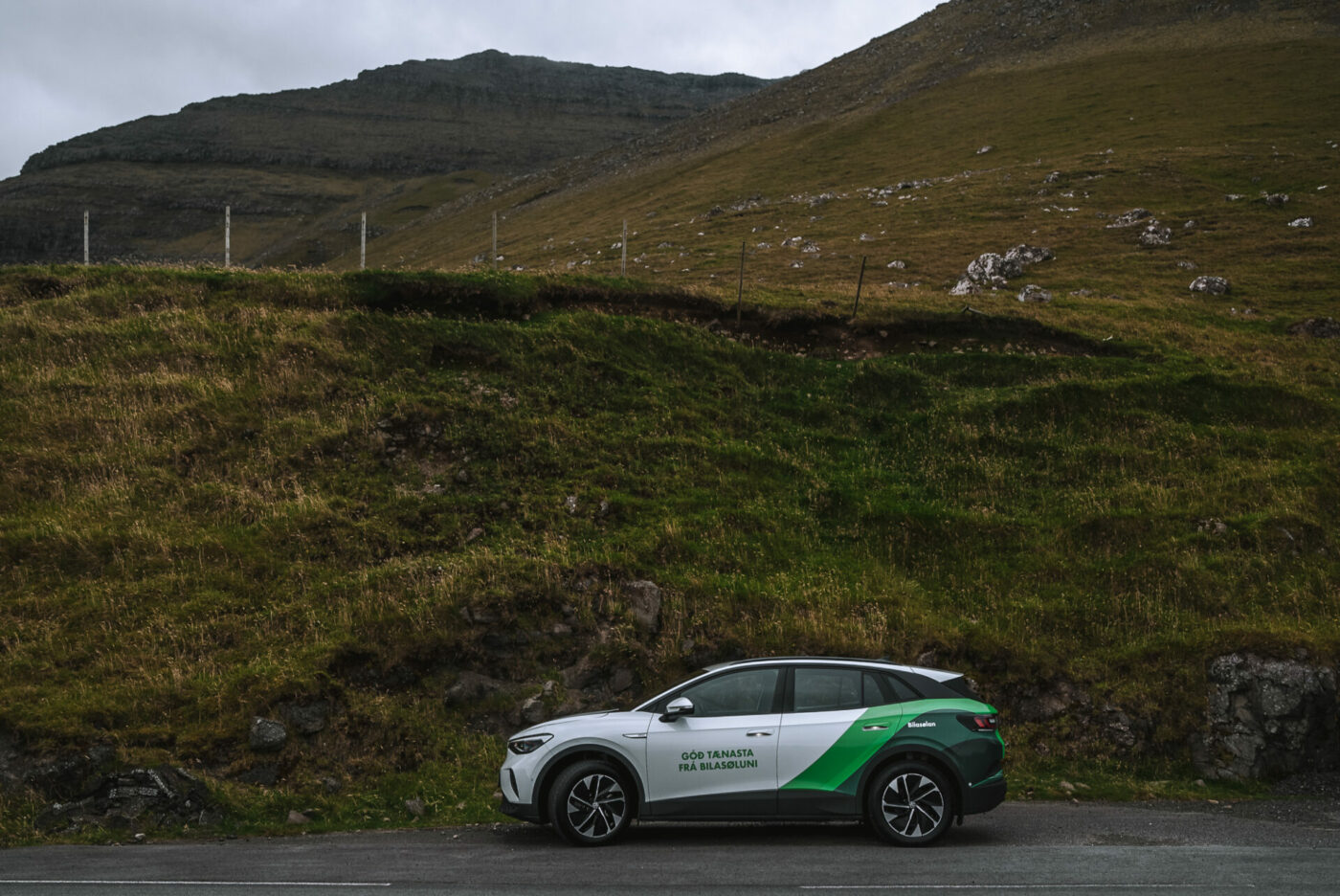
Sustainable Travel in the Faroe Islands
Despite its remote location, the Faroe Islands are becoming an increasingly popular travel destination. In recent years, the number of visitors to the islands has nearly doubled. While tourism growth is good for the local economy, that in the past has been reliant primarily on fishing and sheep farming, sustainable growth is the desired outcome.
Getting around the Faroe Islands with an electric vehicle is one of the many ways you can travel more sustainably in the Faroe Islands. Here are a few other simple things you can do:
- Visit in the shoulders season! The infrastructure in the Faroe Islands isn’t quite ready for mass tourism, but the crowds in the summer descend on the islands in masses. This puts pressure on the fragile ecosystem of the islands and puts wildlife at risk. By visiting in the shoulder season, you will help to relieve the high season pressure and extend the tourism season beyond the summer months.
- If you can’t rent an electric vehicle, reduce your carbon footprint by using shared transportation to get to Torshavn and using free city busses, walking or biking while in town.
- Hop on tours with other travelers so you can carpool to the attractions on other islands
- Choose eco-friendly accommodation options in Torshavn, and opt to stay with locals outside of the capital city. Our stay at Hanusarstova with Harriet and John was one of the highlights of our visit.
- Eat local and with locals. Say no to steak, pork and other meats imported from abroad, and load up on salmon – its sustainably farmed! Check our ROKS for a sustainable upscale dining experience, or book a home-cooked meal experience at Hanusarstova.
- Bring your own reusable water bottle and fill it up straight out of the tap. It’s the cleanest water you will find!
- Hire local tour guides to help support the Faroe Islands’ tourism economy. Search for tours here.
- Leave the Faroe Islands with a few locally made souvenirs to support craft makers and artists on the islands.
And there is lots more! Continue reading below for our list of the best things to do in the Faroe Islands that are both sustainable and enjoyable. By following these tips, you can help protect the Faroe Islands while still having a fantastic vacation.
Best Things to do in Faroe Islands
Streymoy Island
Streymoy Island is the largest and most populated island of the Faroe Islands. It makes up 24% of the total area of the Faroes and is home to 50% of the Faroese population. The island is home to the capital city of Torshavn, as well as a number of smaller villages dotted around the perimeter of the islands. Thanks to a well-connected road system, all villages on Streymoy and other attractions on the islands can be easily reached by car.
Visit Torshavn
Torshavn is the capital city of the Faroe Islands and home to about two-thirds of the islands’ population. This charming city is located on the island of Streymoy and is a great base for exploring the Faroe Islands archipelago.
While in Torshavn, spend a few hours roaming the historical old town. Be sure to visit some of the city’s historic sites, including the Tinganes, the site of Parliament House, Prime Minister’s office and place of annual gathering of the local Viking chiefs, set of unassuming turf-roofed structures, and Skansin, the fort that served as a British Royal Navy headquarters during the Second World War
If you’re looking for some souvenirs to take home with you, Torshavn is also a great place to shop for locally-made clothing, and arts and crafts. There are several shops selling traditional Faroese knitwear, including Ullvøruhúsið and Guðrun & Guðrun, as well as more modern items like jewelry and pottery.
Just on the outskirts of town, you’ll find Svartafoss Waterfall. While it’s not the most impressive waterfall on the Faroe Islands, it’s a lovely little spot surrounded by flowers, grasses, traditional houses and, of course, the sheep.
The arm museum, Listasavn Føroya, is another spot worth visiting for those for a taste of Faroese culture. There are paintings, art installations, and other unique exhibits. The building’s architecture is unique in its own right. There is a lovely café on site, where you could have lunch or an afternoon tea.
For a nice day trip, take a ferry ride over to Nolsoy Island for some great hiking and an opportunity to spot puffins nesting here from early May to August. The Nolsoy village is as tranquil as they get!
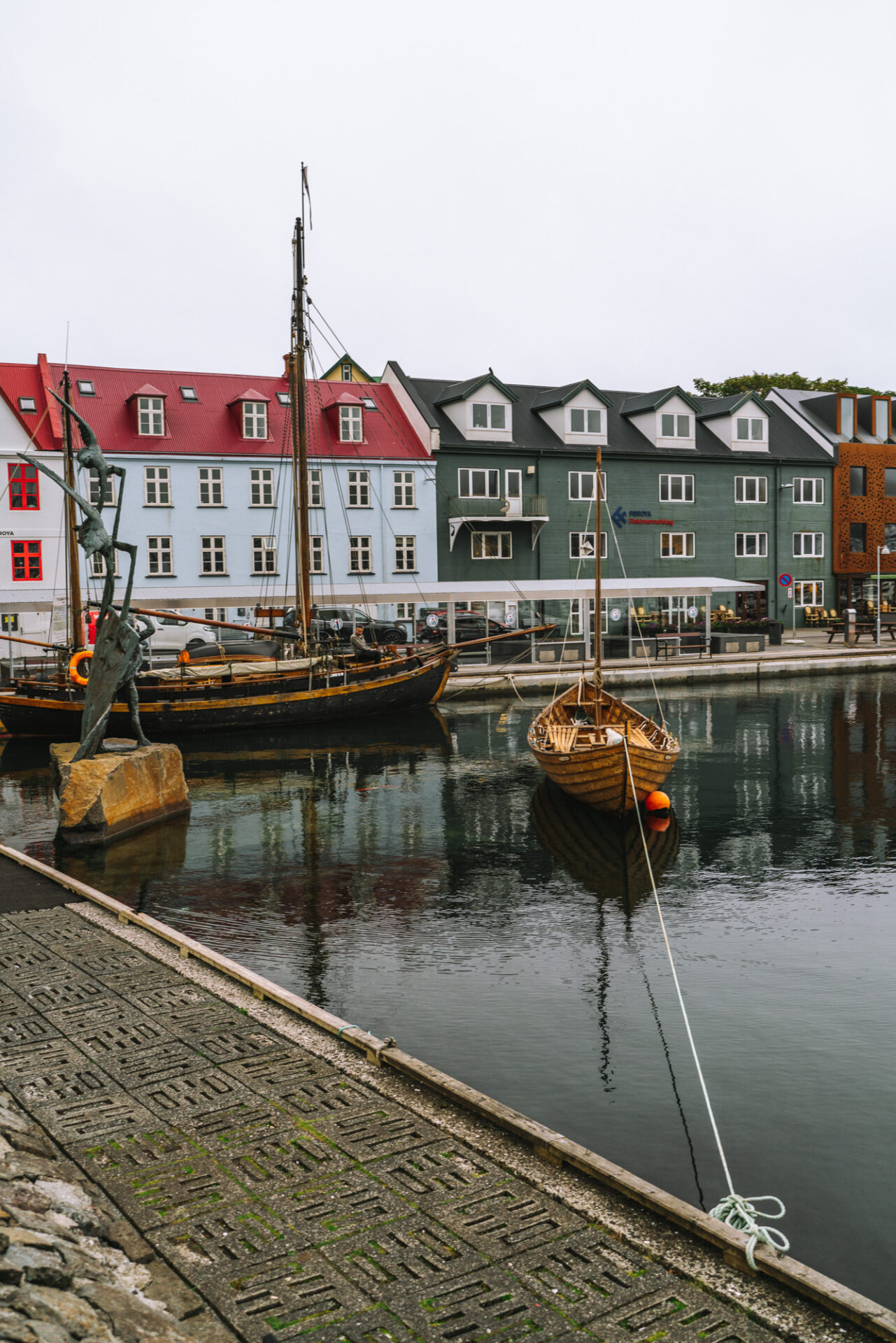
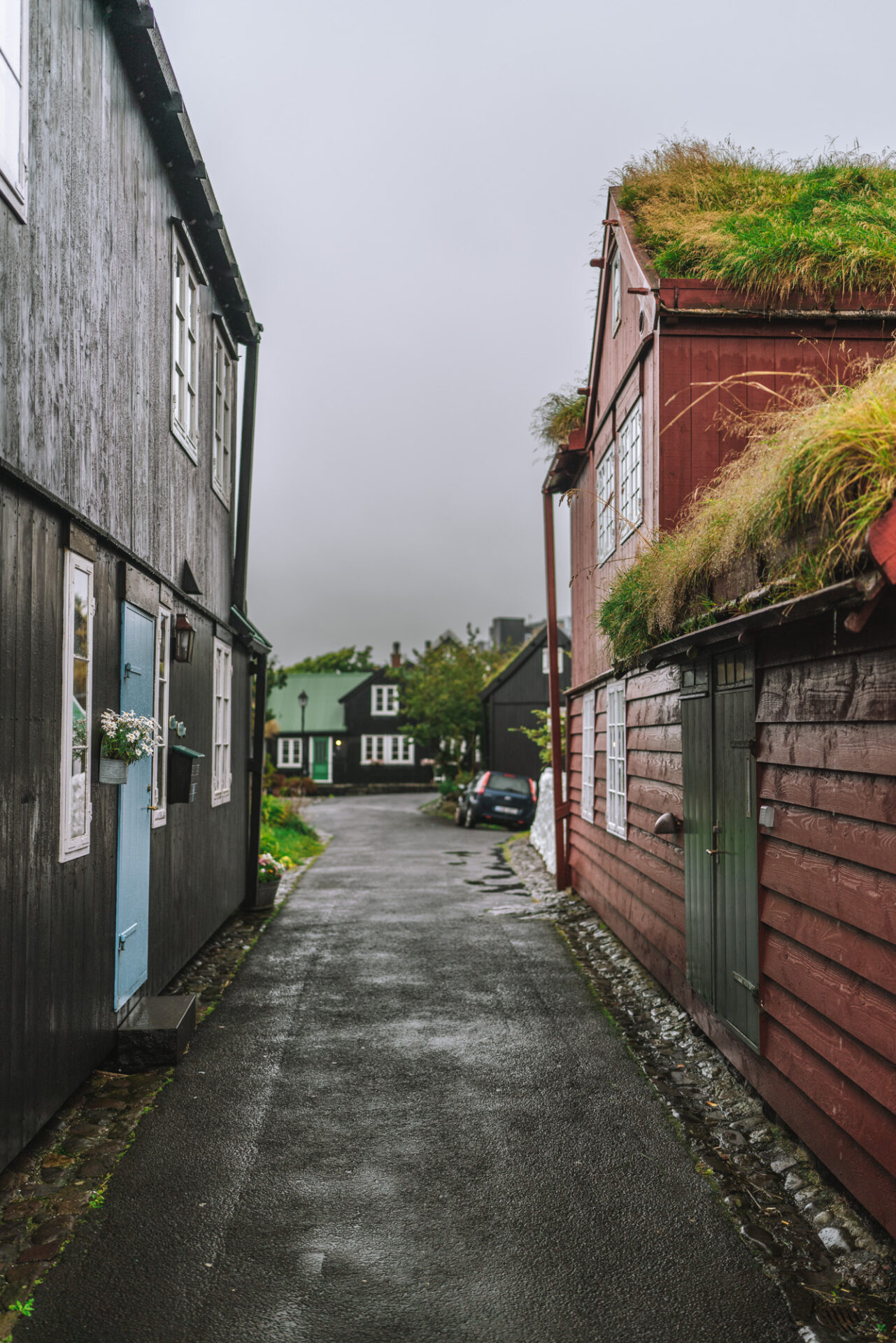
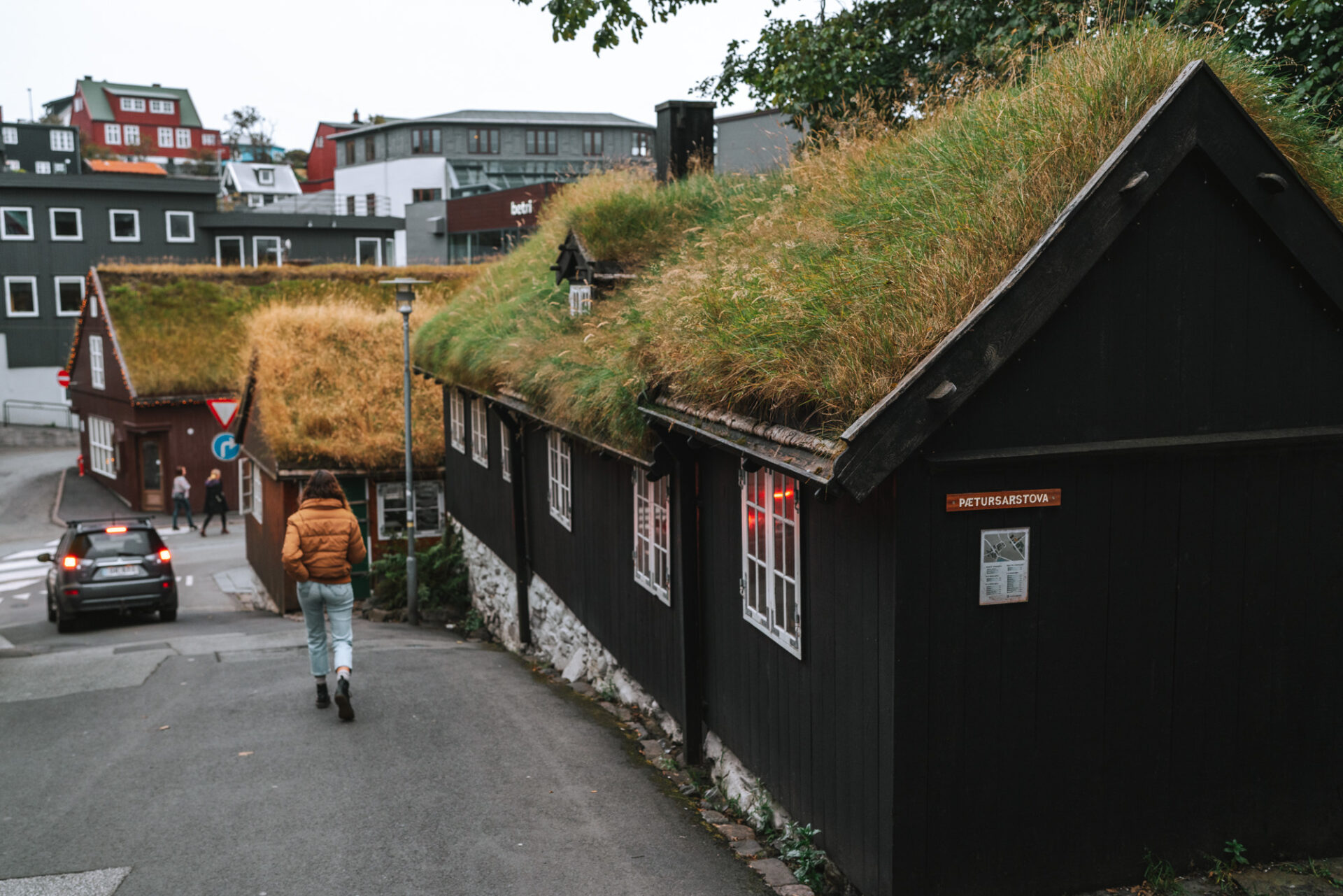
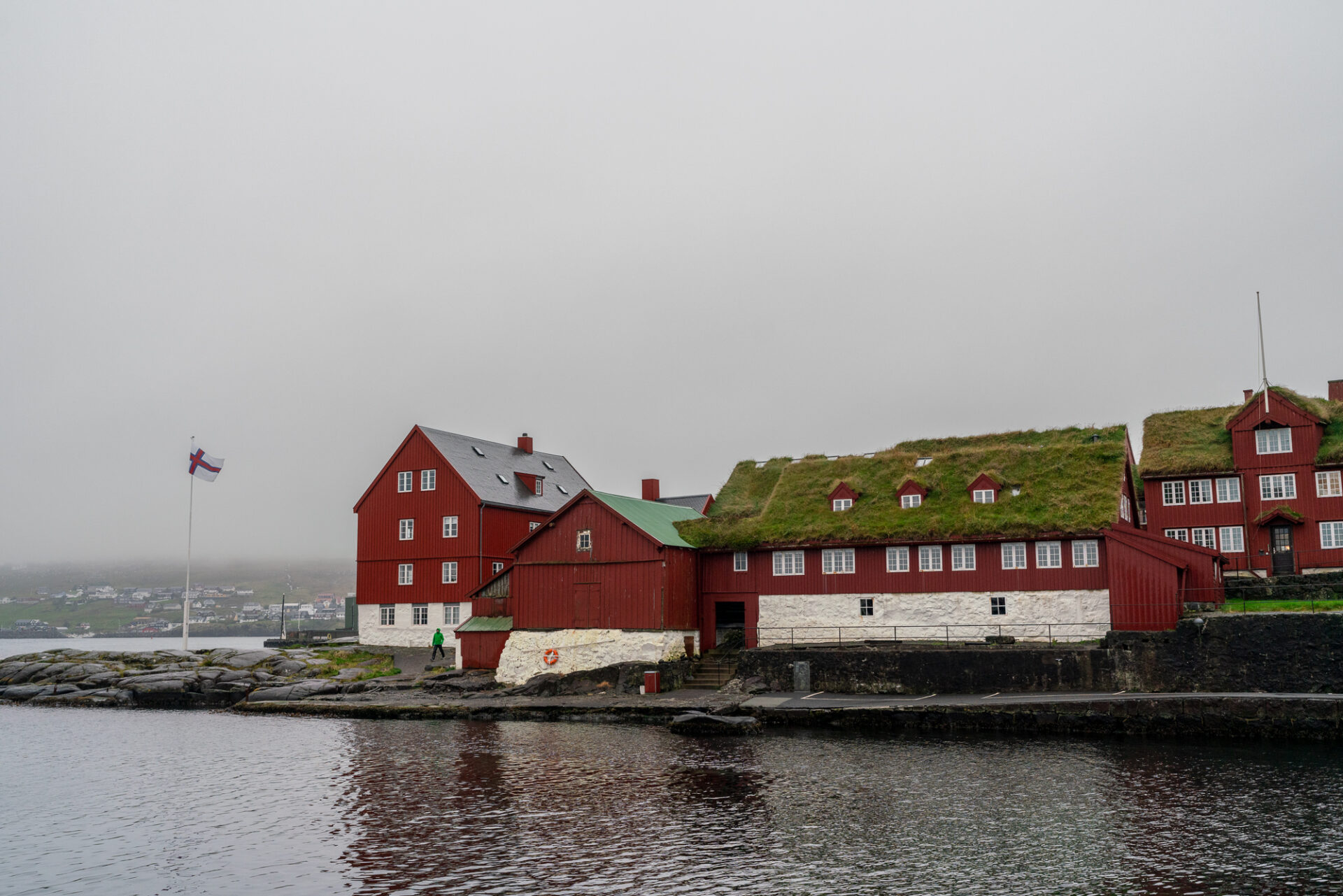
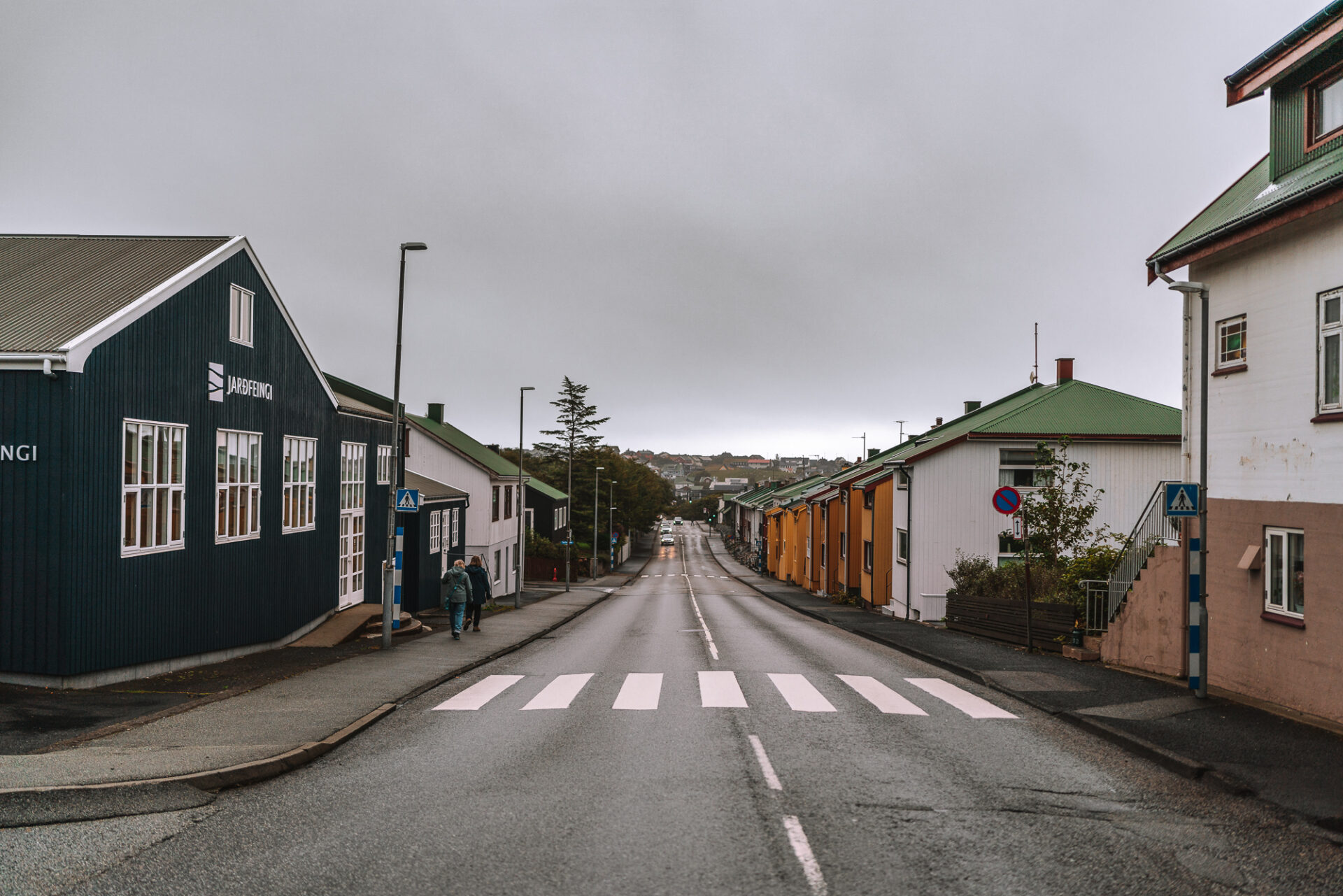
Visit the Village of Kirkjubour
The town of Kirkjubour, located just 15 kilometres out of town, is a charming remote village and the location of the island’s most significant historical site.
The ruins of an old Kirkjubour church are all that remain in this small village, which was once the cultural and episcopal center for all of Faroe Islands. Today, you can see 3 main elements: the 900-year-old farmhouse/museum Roykstovan, the Parish church, Ólavskirkja, built in 111, and the medieval Magnus Cathedral, built in the 1300s.
The road to Kirkjubour is part of the adventure. We rented e-bikes from a bike shop in Towrshavn and made our way there on 2 wheels. We admired beautiful turf-roofed houses, and hundreds of sheep grazing on the sides of the road, passing through the town of Velbastaður en route. The stretch between Velbastaður and Kirkjubour was the most scenic as it hugged the coastline leading up to this important historic site in the village. Up for a challenge? Why not walk to Kirkjubour following a historic route all the way from Torshavn?
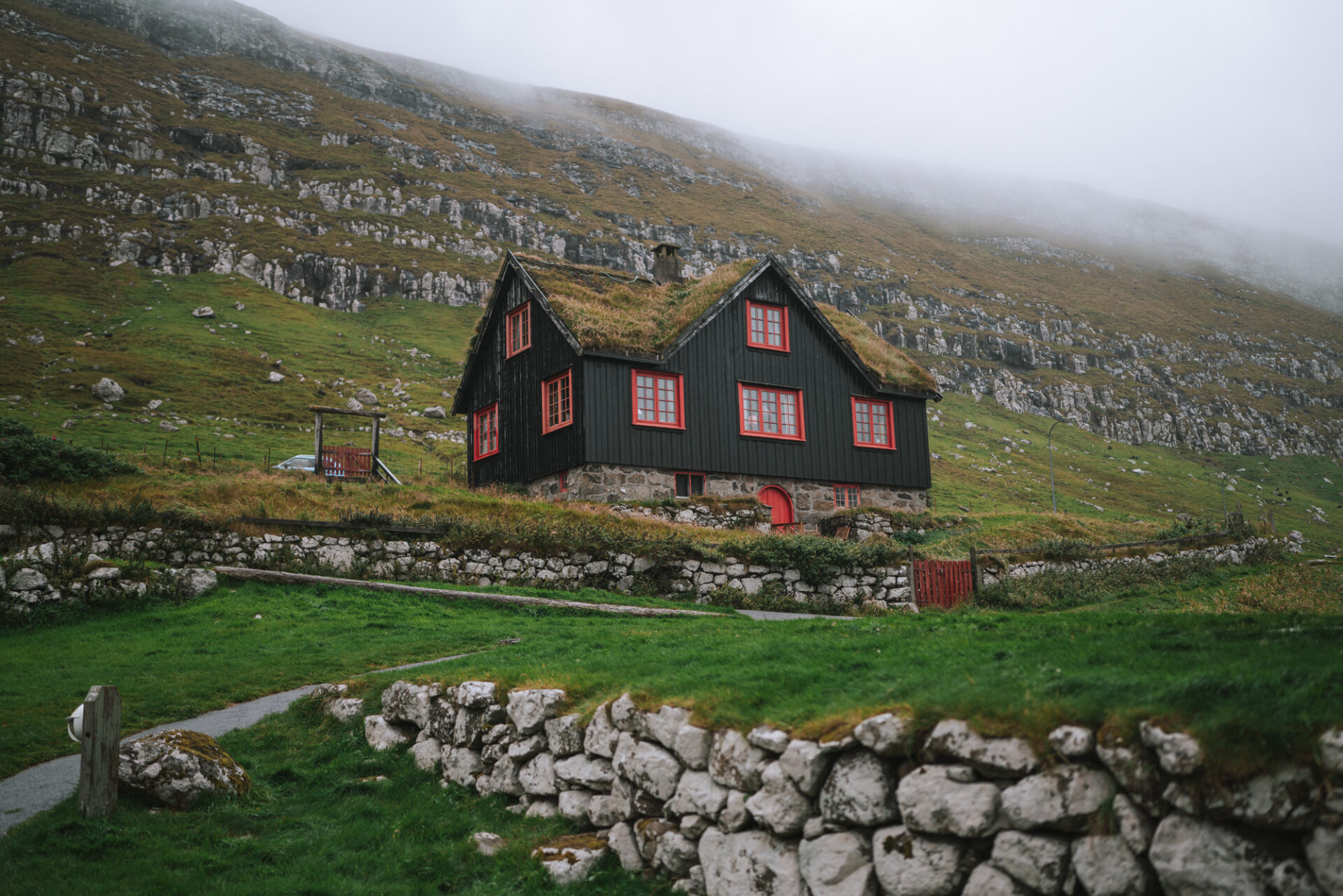
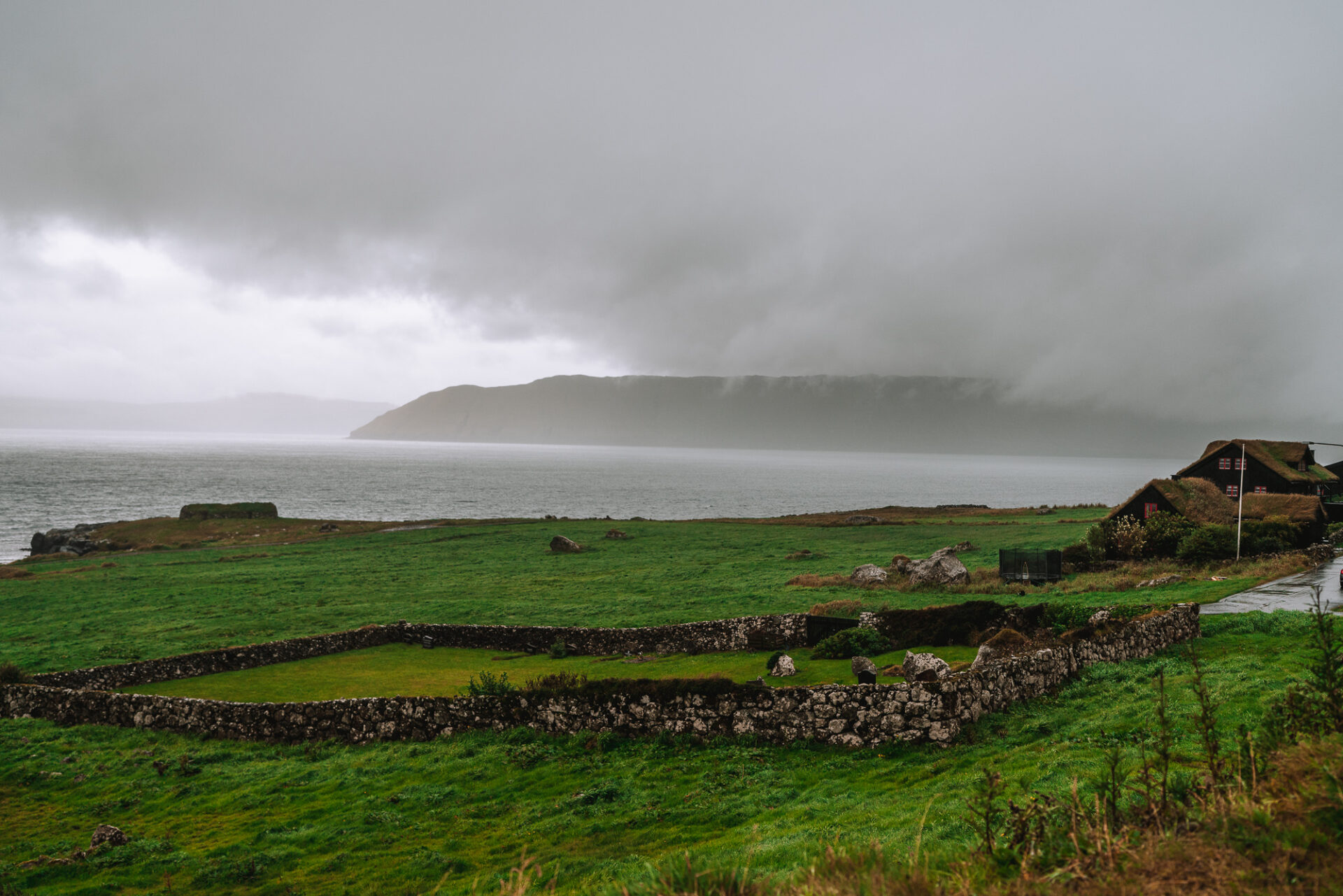
Go surfing in Tjørnuvík
Viking graves found in the eastern part of the valley indicate that Tjørnuvík is one of the oldest settlements in the Faroe Islands. The sleepy village, located on the northern tip of Streymoy Island, faces the open ocean, offering a distant view the famous Giant and the Witch rocks. According to the local legend, the Giant and the Witch tried to drag the Faroe Islands to Iceland and remain an important part of local folklore.
Aside from the views, Tjørnuvík is also known as a great spot for surfing in the Faroe Islands. Surfing in the North Atlantic Ocean can be both exhilarating and extremely dangerous, reserved only for experienced surfers. A local team of experienced surfers offers guided surf tours right here in Tjørnuvík.
There is a popular hiking route from the village of Tjørnuvík to the village of Saksun. The trail is 6.5km each way with 500m of elevation. It ts important to note that the trail runs through private land of a farmer in Saksun, who is not particularly fond of tourists. To respect his privacy, we choose to skip this hike during our visit.

Feel the Power of Fossa Waterfall
Fossa Waterfall, located just about an hour north of Torshavn on the Eastern side of Streymoy Island, is the tallest waterfall in the Faroe Islands. The waterfall is 140 metres tall and the dark basalt wall offers striking contrast to the white water that cascades below. Fossa Waterfall is particularly impressive on rainy days when the flow increases. You can park close to the fall and walk up almost to its base to feel the misty spray and the real power of this beautiful sight.
Go Birdwatching at Vestmanna Sea Cliffs
One of the most popular things to do in Faroe Islands is hidden on the Western side of Streymoy Island. The village of Vestmanna serves as a starting point for the Vestmanna Sea Cliffs tour, a boat tour to the grottos and 2000 feet high vertical sea cliffs, where birds such as puffins, guillemots, fulmars and kittiwakes nest each summer.
Boat trips to the sea cliffs operate only in the summer (May-August), when bird nesting activity is at its highest. Tickets start at USD $75 for a tour that lasts about 90 minutes.
Go Kayaking in Leynar
The tiny village of Leynar, located on Streymoy’s west coast, is a charming beach town that’s a favourite with locals and visitors in the summer. The water here stays cold throughout the year, but that doesn’t stop the locals from taking a dip in the clear waters.
We weren’t brave enough to jump in mid-September, but we found a great way to see the sheer cliffs and caves along the shore on a kayak. We joined Sigurd and his crew from Kajakk Faroe Islands for a very cool guided sea-kayak tour in Leynar. We kayaked through the sea stacks, and into caves, getting up close to beautiful rock formations.
If there is one thing we learned about kayaking in the Faroes is that this activity is very weather dependent. The unpredictable and harsh weather on the islands can make it very challenging to kayak in Leynar. But don’t fret, Sigurd has plenty of tried and tested kayaking spots all over the island and is bound to find something that works for you!

Admire the Týggjará Waterfall
Týggjará is another impressive waterfall on the Eastern side of Streymoy Island. It’s located right next to the road and makes for an easy drive-by attraction. You can park in a lot next to the falls, and walk up to its base for an up-close view. The waterfall empties into the Kaldbaksfjøður fjord.
Watch Sunset at Sornfelli
Sitting at 725m elevation, Sornfelli is another popular peak on Streymoy island. Its two white domes can be recognized from a distance. The trip to the top is not as challenging as you might think. You can drive all the way to the top of the mountain following a narrow road. The plateau at the top offers amazing views of the surrounding area and, on a clear day, acts as a great spot for sunset viewing.
Eat at ROKS
There are plenty of restaurants to try while in Torshavn (which we mention later on in this article), but ROKS is so unique it deserves a shout-out of its own!
The laid-back sister restaurant to Michelin-starred, KOKS (as of 2022, operating as pop-up in Greenland), ROKS keeps the emphasis on unique Faroese ingredients and truly local flavours. The menu is fixed with a 5 or 7-course experience and dishes that change seasonally in response to produce availability on the islands.
We were blown away by the creativity and flavours of the dishes during our 5-course meal. The codfish skins, monkfish cheek and panfried capelin left a lasting impression. Great selection of wine and an ideal setting for a romantic or celebratory night.
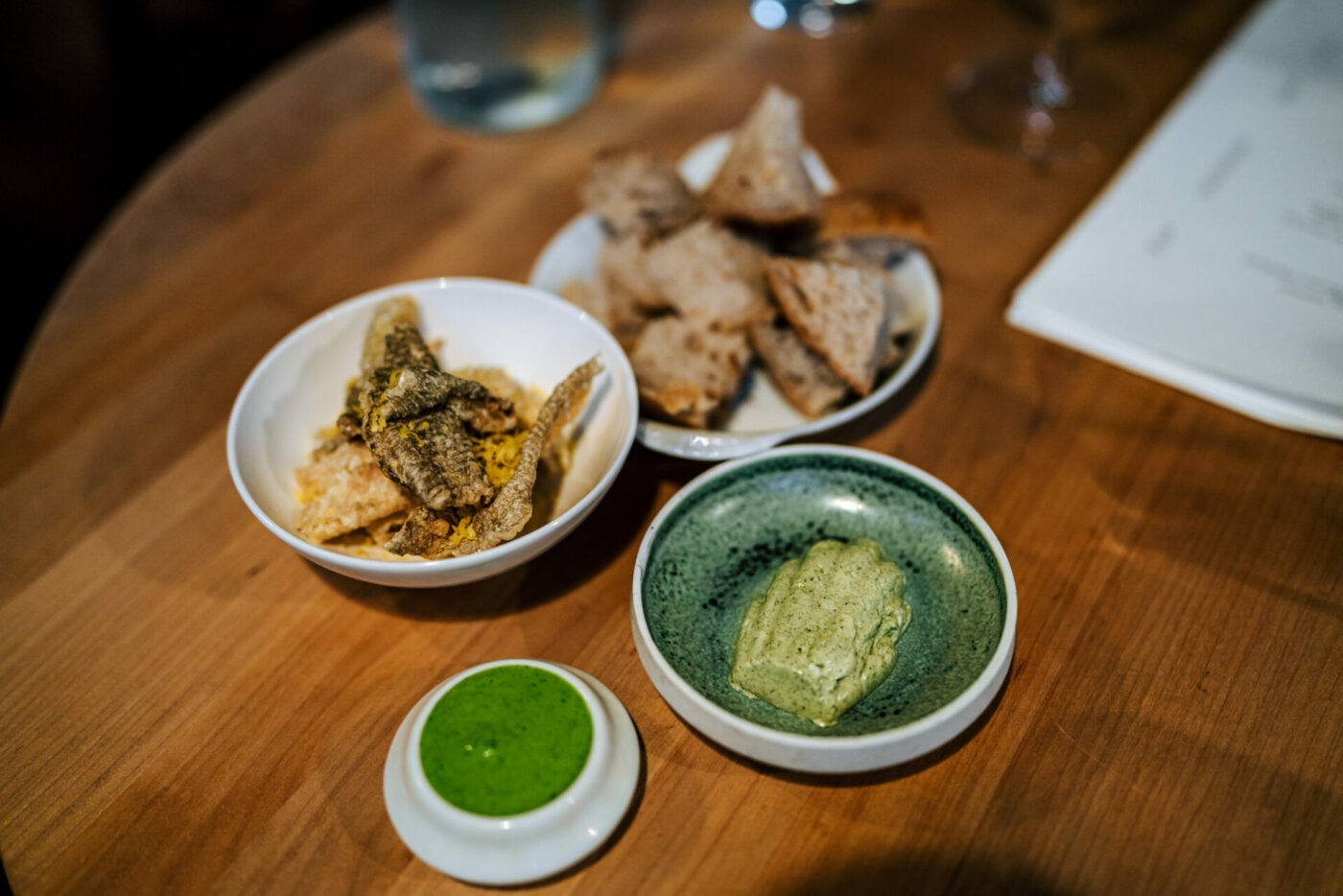
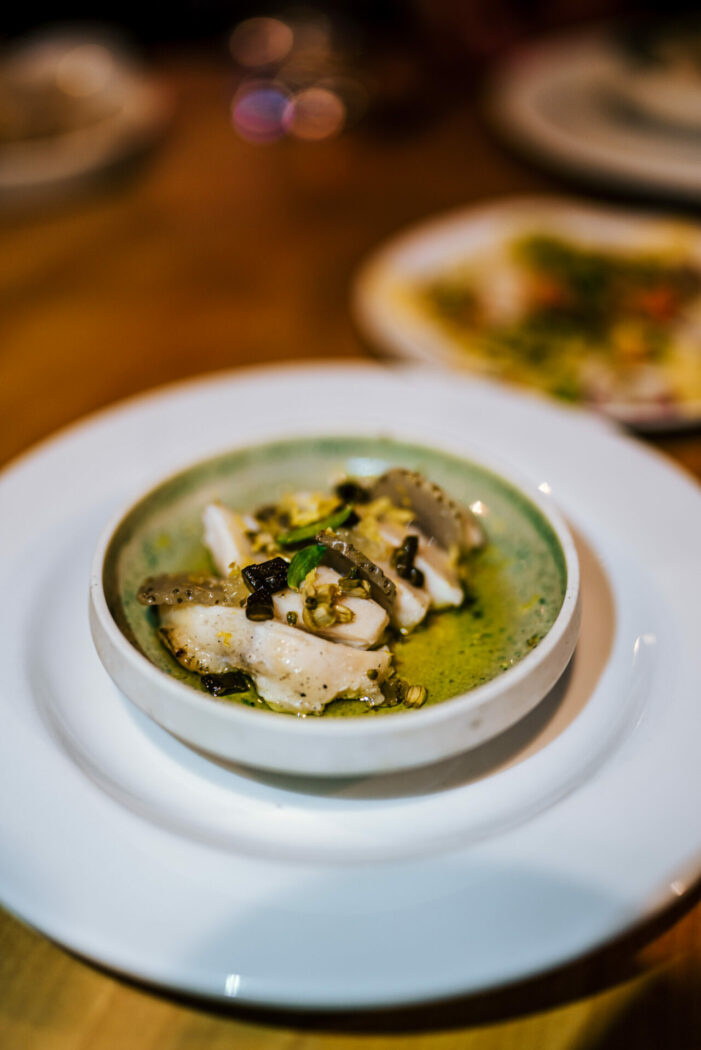
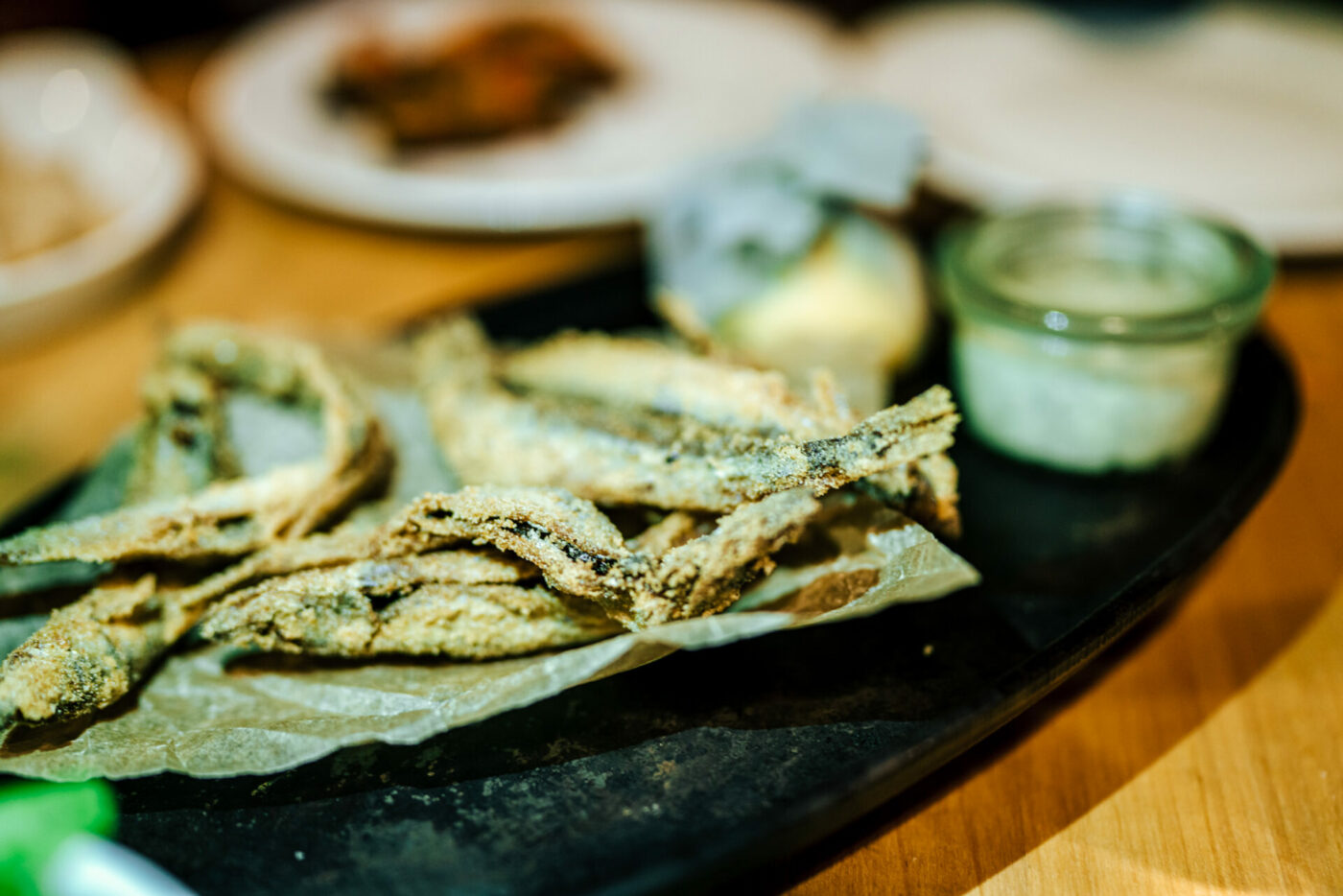
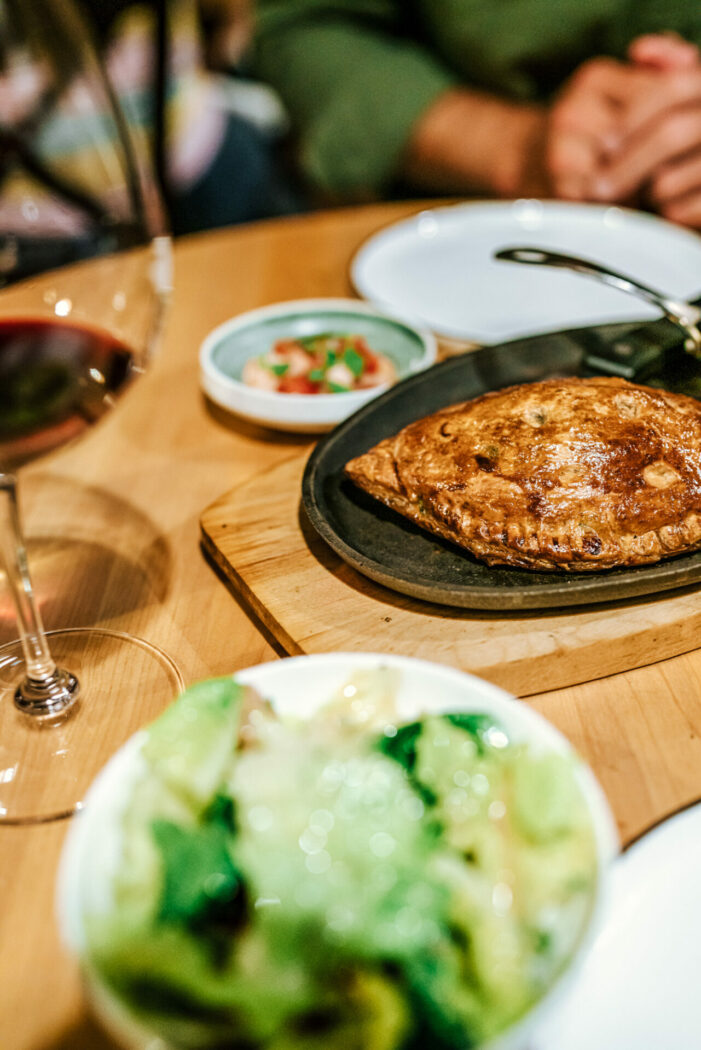
Eysturoy Island
Eysturoy is the second of the two most populous islands in the Faroes and one that offers a number of top things to do in Faroe Islands. The island is home to the tallest mountain in the Faroe Islands, ancient Viking settlements and the charming villages of Gjogv and Funningur.
Hike to the top of Slættaratindur
Hiking is one of the top activities to do in Faroe Islands, so no matter your fitness level, we encourage you to hit the hiking trails while here. It truly is the best way to see the natural beauty and appreciate the rugged landscapes of the Faroe Islands.
There is no shortage of hiking trails in the Faroe Islands, but if you only have time for one hike – make it the ascend to Slættaratindur, the highest mountain in the Faroe Islands. Towering at an impressive 882 meters (2,894 feet), Slættaratindur, translated as “flat summit”, is a medium-difficulty hike that offers stunning panoramic views. The climb to the top is challenging but rewarding, and on a clear day, the views stretch all the way to Iceland.
NOTE: Most of the hiking trails in the Faroe Islands are privately owned by local farmers, who, for the most part, tolerate locals and visitors on their property without too much fuss. But as a results, this trail and many other hiking trails in Faroes are not very well marked or maintained, leaving it up to the hikers to “pave” the way.
If you are looking for other more authentic village hikes in Faroe Islands, this guide on Hiking in Faroe Islands will help. The site features a plethora of hikes that can be sorted by distance, difficulty and duration and focuses on the old village paths and well maintained trails, which are open to everybody.
While the Slættaratindur trail wasn’t particularly challenging to find, the parking lot at the start of the trail is well marked on Google Maps and is easy to navigate, we appreciated having a local guide, Óluva, leading us to the top of the mountain. Her honest responses to our questions and delightful stories kept us entertained en route – making the hike a lot more enjoyable.
And the views at the top – well… see for yourself!
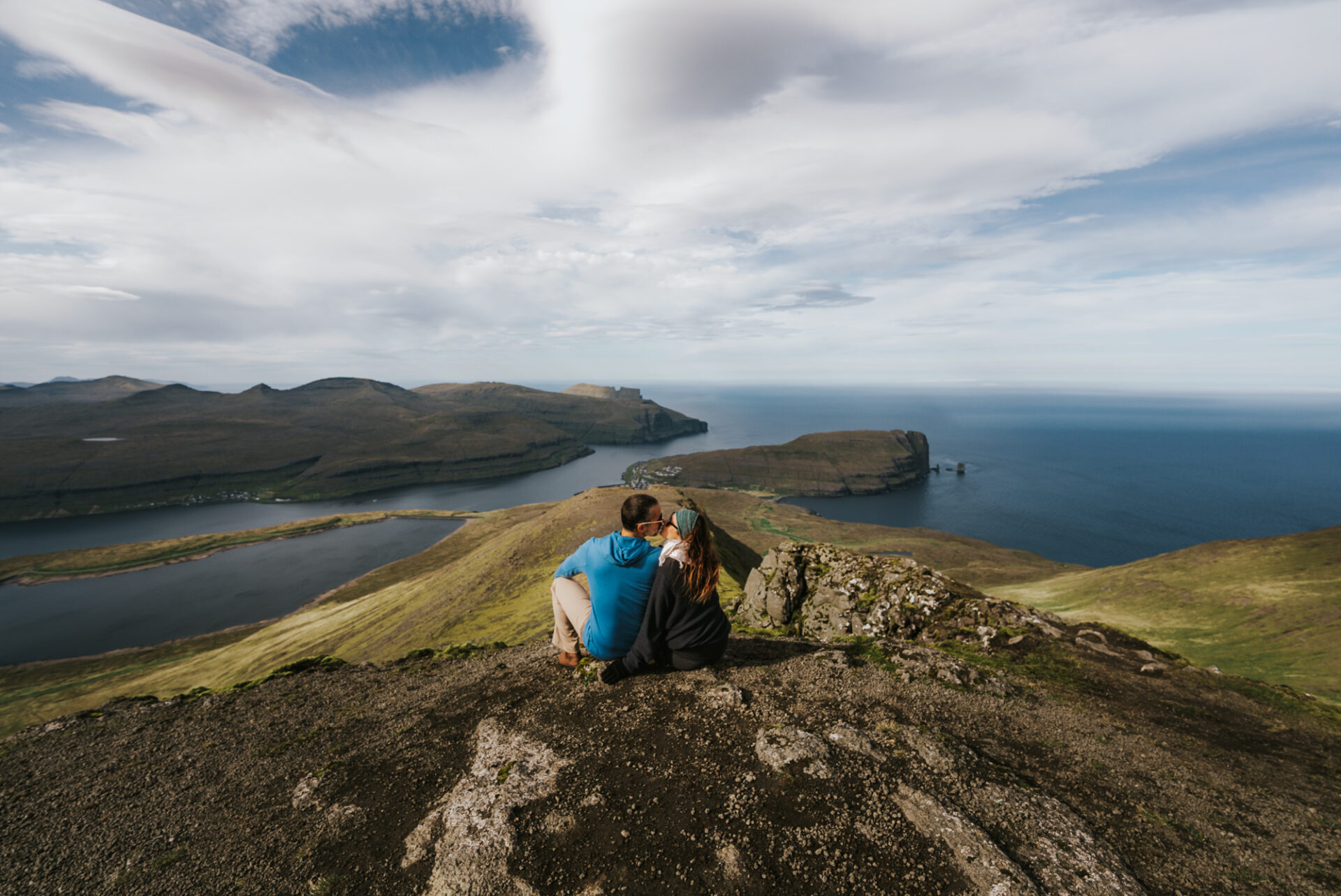
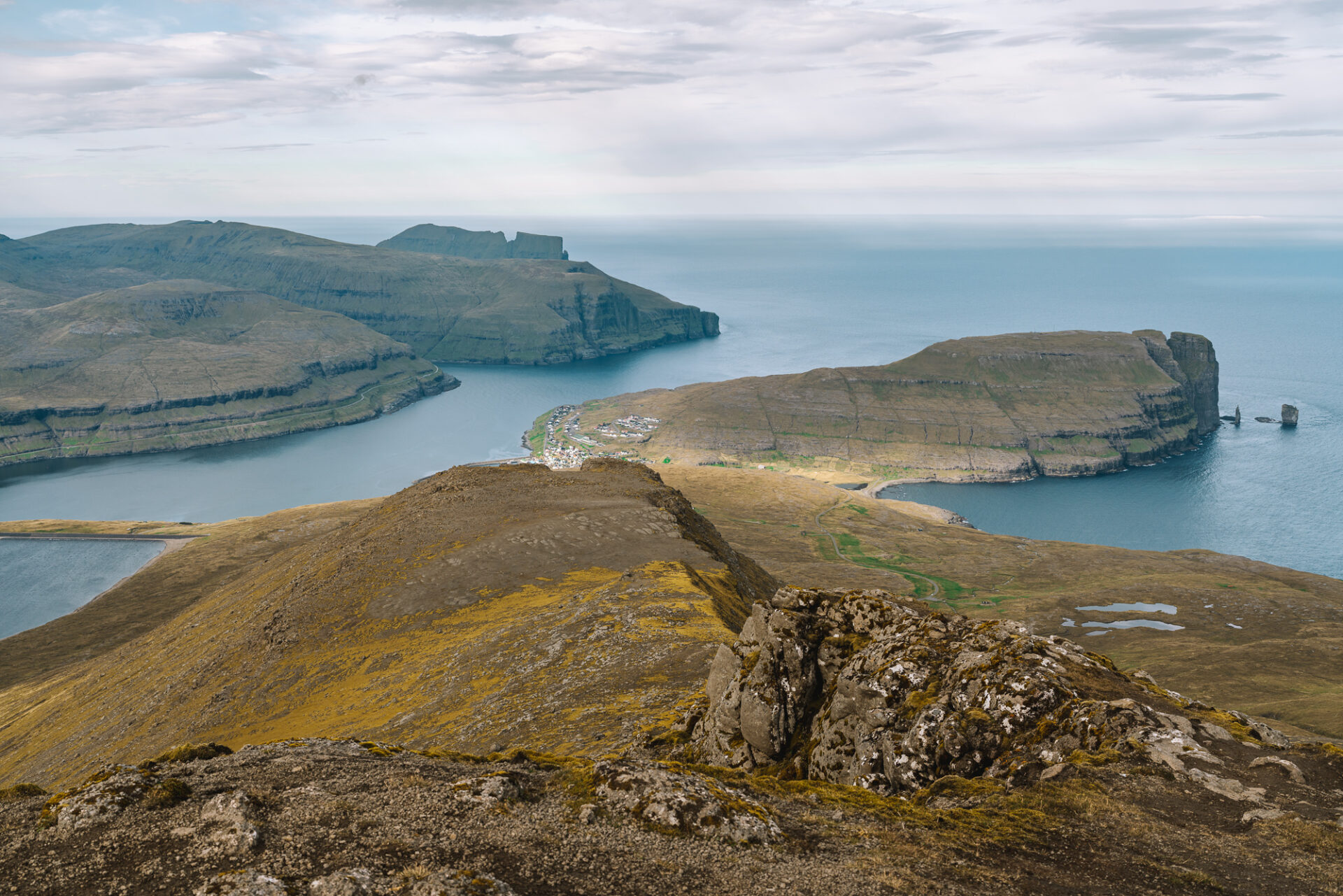
Visit the Charming Village of Funningur
The queit settlement of Funningur at the base of Slættaratindur mountain is the place where first settlers arrived in the Faroe Islands. The town looks beautiful from the scenic view point just outside of town. The charming turf-roofed church is the biggest attraction in the village.

Check out the Village of Gjogv
Located on the northeast tip of Eysturoy island, Gjogv is another scenic village worth visiting. The remote village is known for its 200-metre-long sea-filled gorge that snakes its way through the village.
Go Fishing
The town of Ljosa served as the starting point for boat tours with a local company, Boat.fo
We joined Samson, a local fisherman and the founder of Boat.fo, for a Fish, Visit and Dine Tour on a beautiful day while in the Faroes. The trip offered so much more than a genuine fishing opportunity. We sailed in a traditional Faroese boat, an authentic Faroese handicraft, through the fjords and dramatic landscapes in the northern part of Eysturoy island. “This area is teeming with fish”, he said while hooking two pieces of shrimp on his fishing rod, “…just wait and see”.
We weren’t sure if it was the live bait (in an attempt to reduce plastic in the ocean, the use of artificial bait is forbidden in the Faroe Islands), or the richness of the region, but it took precisely 3 minutes for Max to reel in his first catch. A few more casts and our buckets were full with 3 beautiful cod, and a pink snapper.
After a bit more time on the water, navigating along sheer cliffs and the famous Giant and Witch rocks, we anchored at Ljosa. Next up – was dinner with our fresh catch – courtesy of the lovely, Rose, from Rose’s Cafe. Ethnically Ethiopean, but Faroese at heart, Rose made us the most incredible fish, bathed in a rich, creamy sauce. An experience to remember!

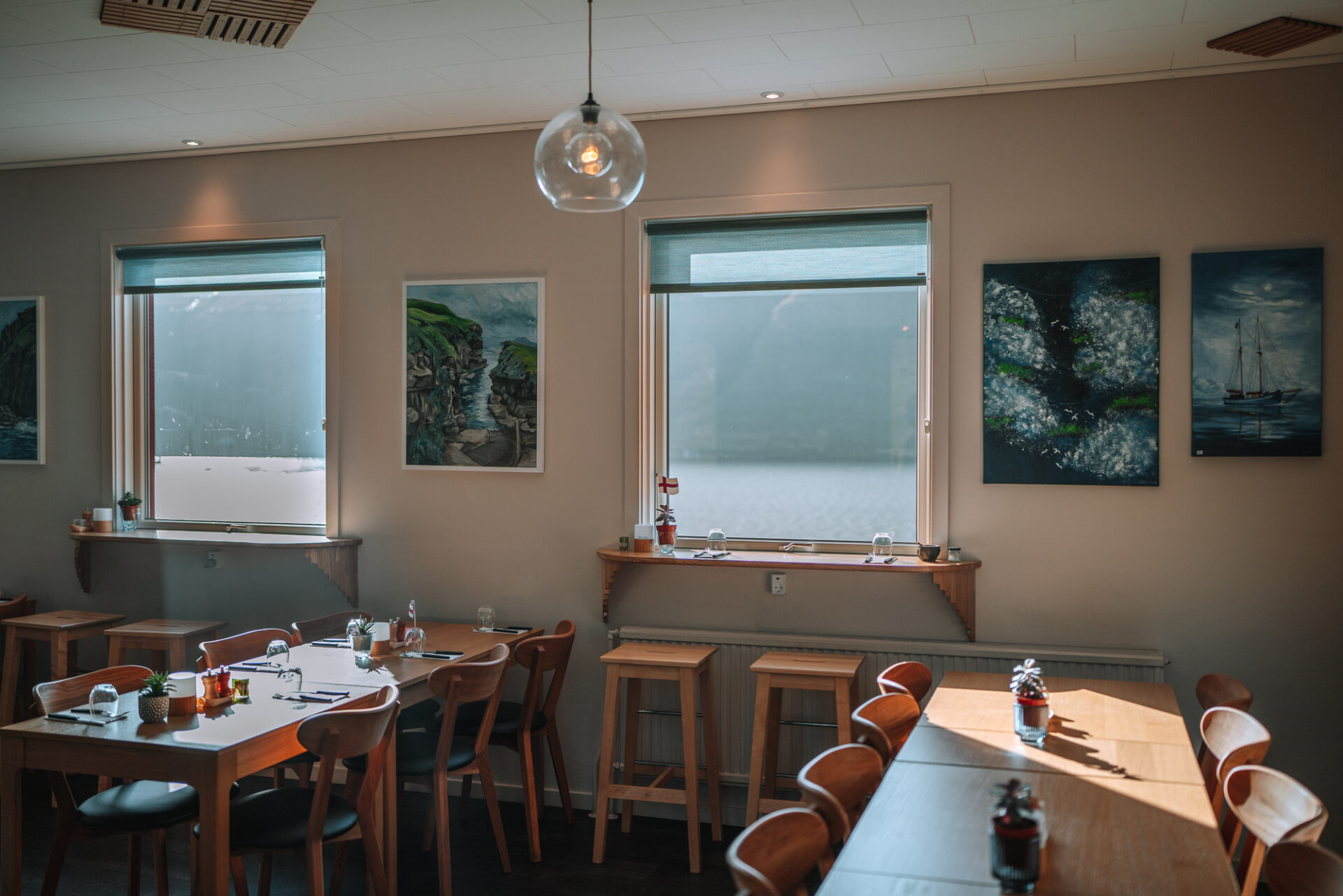
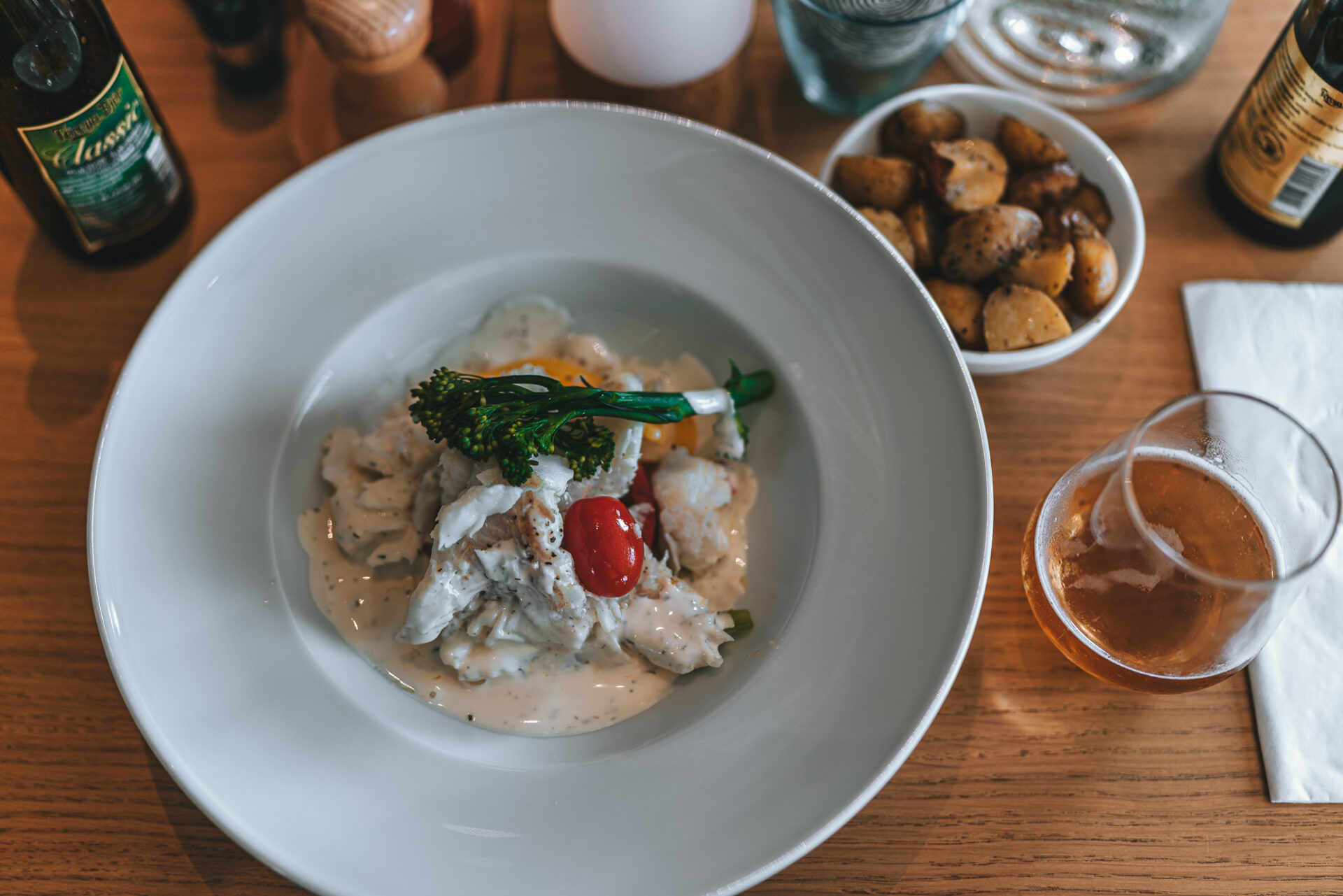

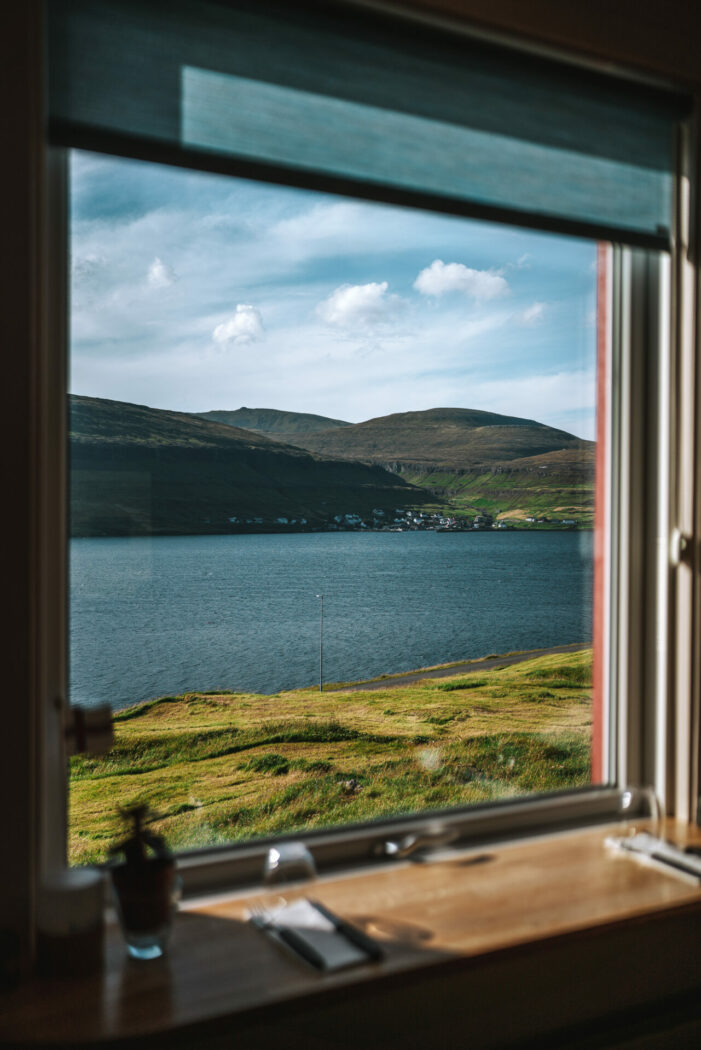
Stay and Dine with Locals at Hanusarstova
Our stay and meal at Hunasarstova was the most culturally enlightening and immersive experience of the entire trip. What started as a simple farm stay became a night to remember when hosts Harriet and John invited us to join them for dinner.
Located in the small village of Æðuvík, Harriet and John are a young couple who have recently built the most beautiful tiny cabin on their farm. Situated amidst a lush green pasture, offering ocean views, the cabin is a light and peaceful space with minimalistic design details, a gorgeous, luxurious Scandinavian-style bathroom, and stunning prints adorning the walls. The models in the photos are none other than the proud residents on the farm – Harriet’s sheep that roam freely all around the cabin and beyond.
Harriet is a fifth-generation farmer who has taken over her father’s farm in an attempt to defy the norms of traditional farming and prove that modern sheep farming can be profitable. She’s young, creative, fun and determined – a stark contrast to the typical profile of a Faroese farmer.
Their new cabin is yet another revenue stream for the farm, along with the occasional family-style meal that Harriet prepares and shares with their visitors.
We felt incredibly lucky to have experienced the feast firsthand, the meal full of life and colour rooted in tradition and authentic Faroese fare. Recipes passed down through generations offered a modern twist – reflective of Harriet’s vibrant personality and youthful attitude. Everything was delicious. But it was the mealtime conversation that filled our cups more than wine that night. Harriet and John were not shy to share true insights into life on the Faroe Islands. We discussed politics and cultural beliefs, the evolution of tourism on the islands, and so much more. There is no better way to experience true Faroese culture than with a stay at Hunasarstova.
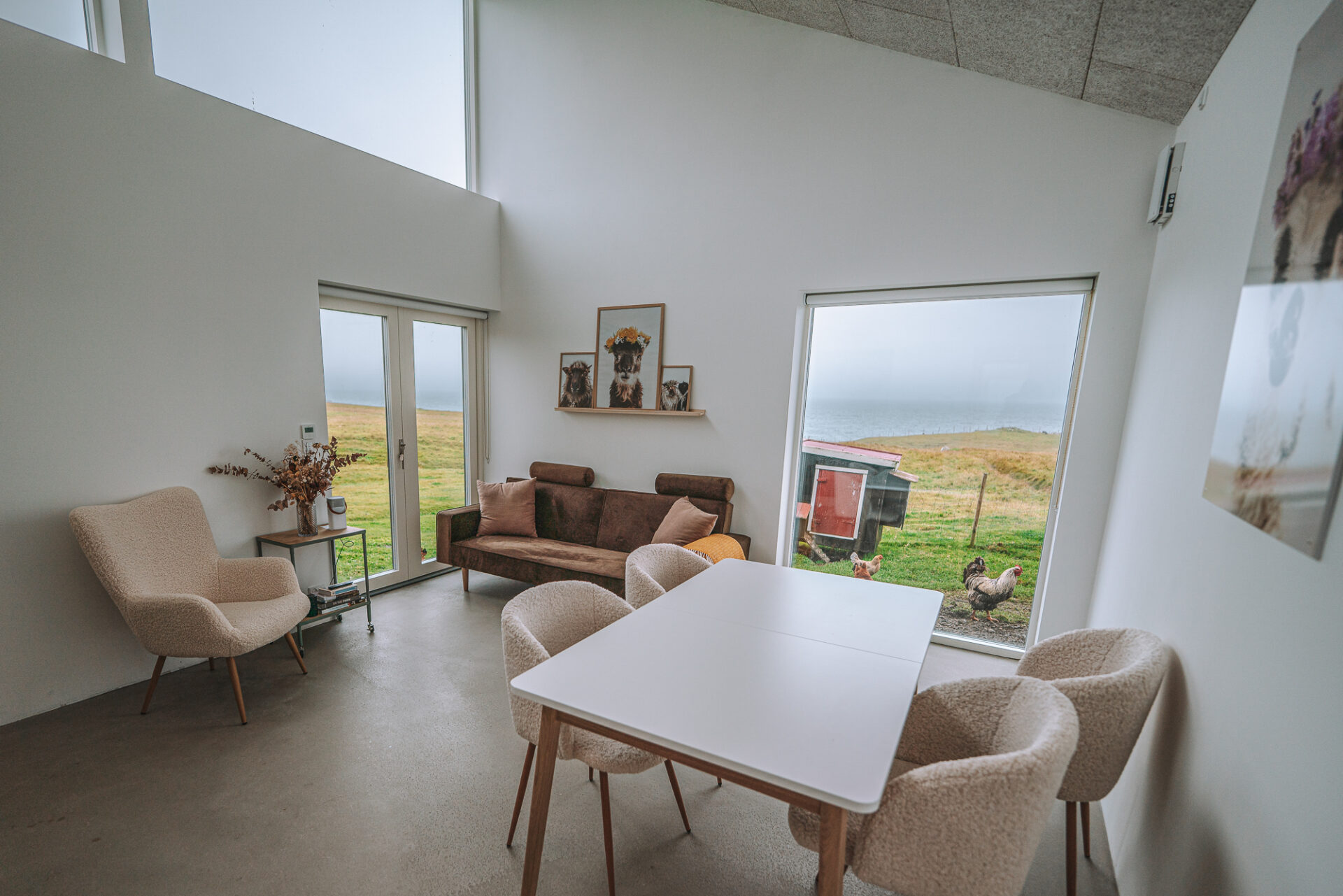


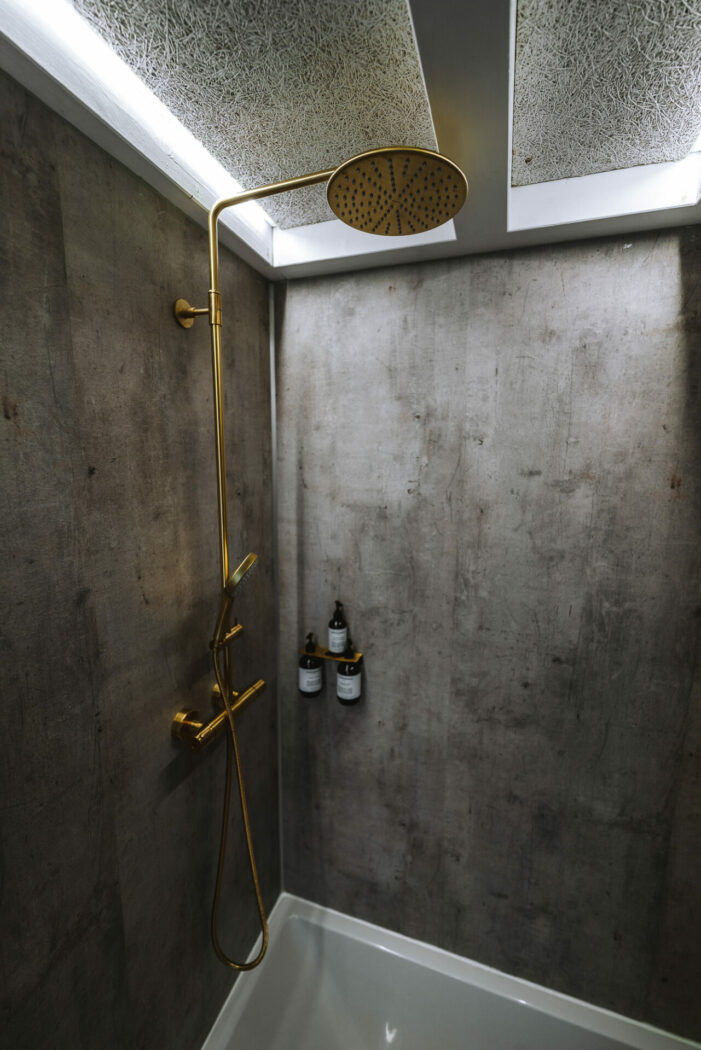
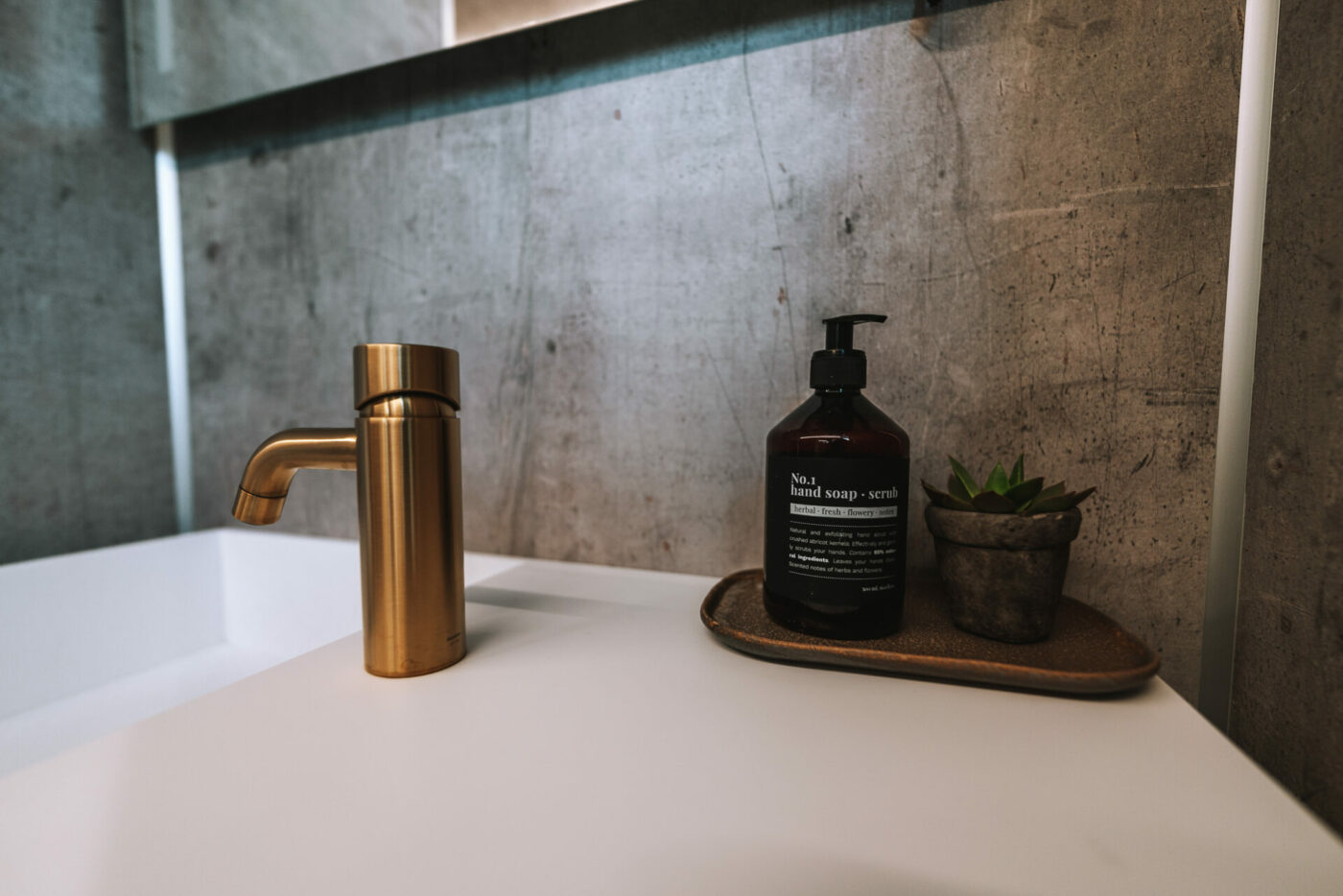
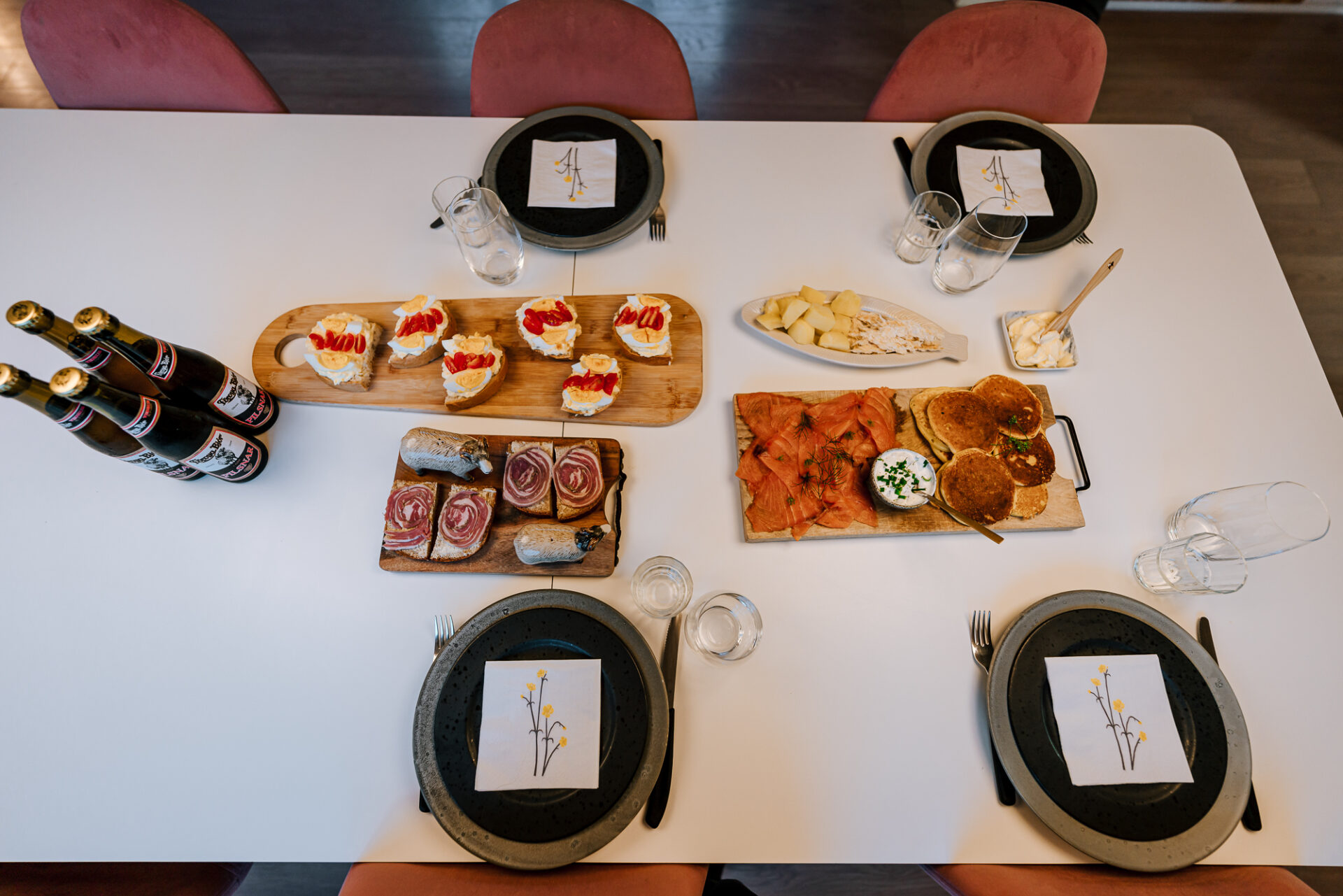
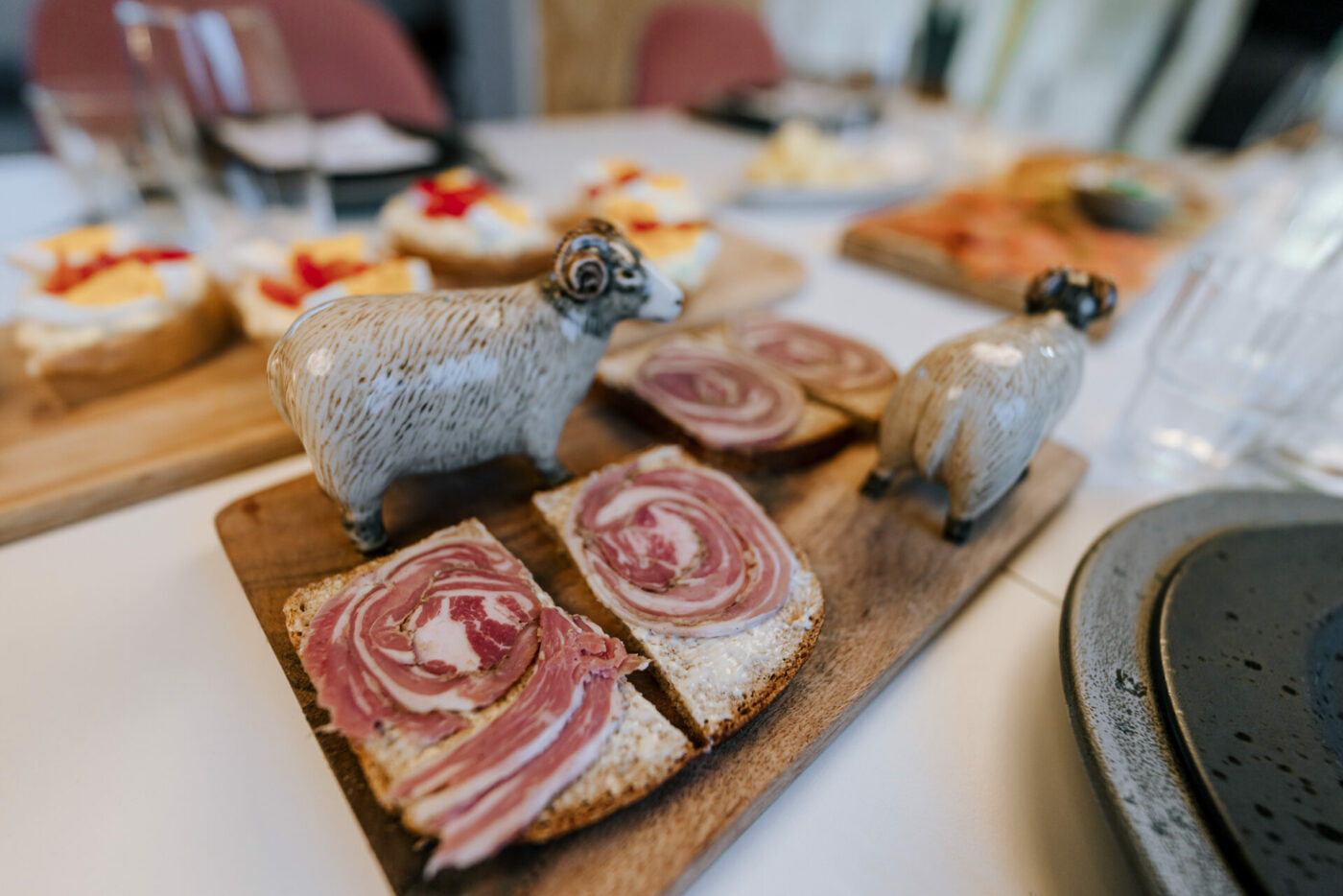
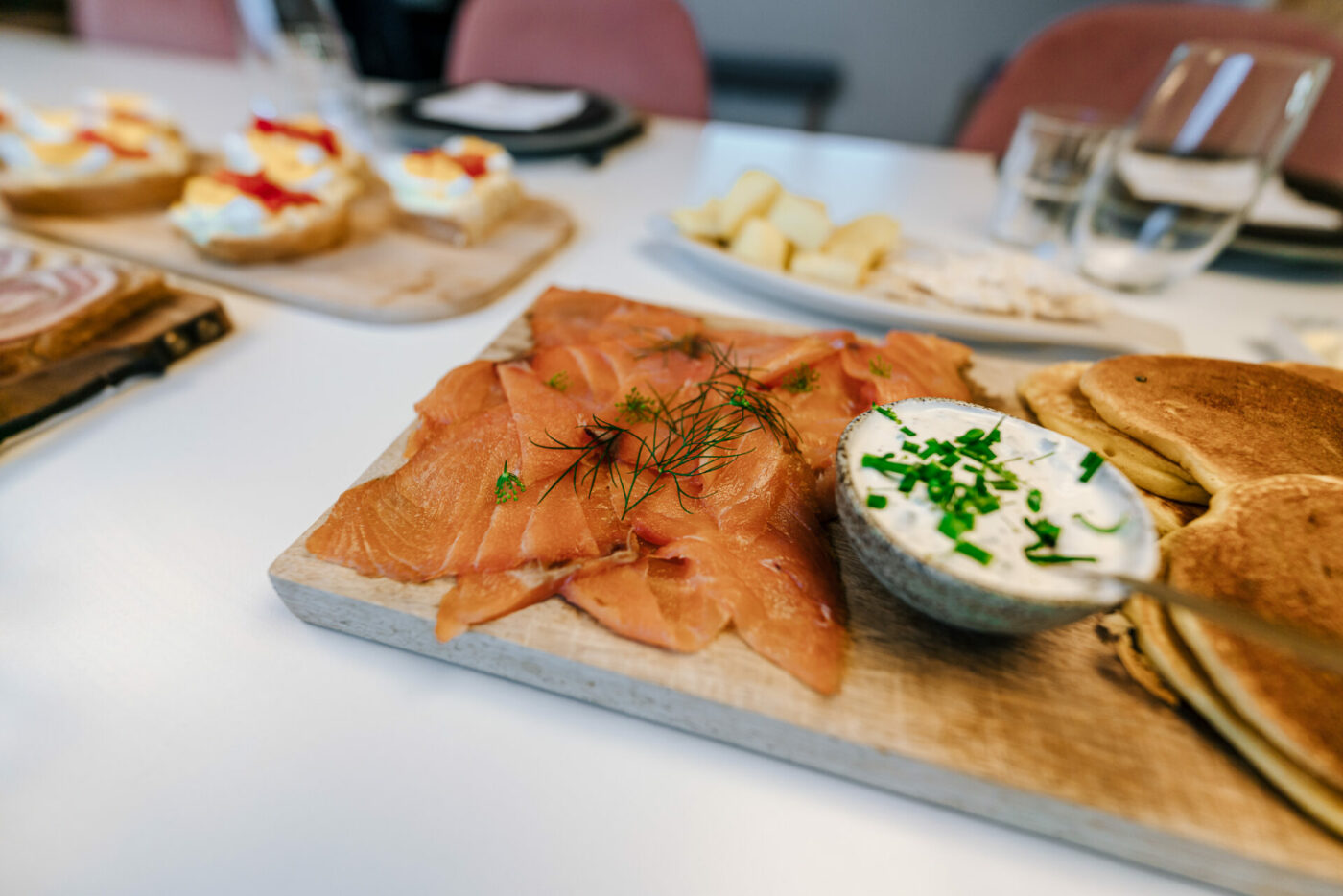

Vagar Island
Vagar is the most westerly island in the Faroes. It’s home to the Vagar International Airport and Mulafossur, the most picturesque waterfall in the Faroe Islands.
Visit Mulafossur & Skarðsáfossur Waterfalls
Mulafossur Waterfall is one of Faroe Islands’ most popular tourist attractions. The waterfall is located on Vagar Island in the small town of Gasadalur.
The waterfall is just 20 mins from the airport, making it a great first stop on your list of things to do in Faroe Islands. There is a pullover and a small parking lot beside the trail that leads to the famous viewpoint of the waterfall. A short walk gets you to the observation platform from which you can see the majestic falls. In the high season, it is best to park in the town of Gasadalur and walk to the waterfall from there. The walk from town is only 5 minutes.
A lovely 3 km coastal walking trail leads from Mulafossur to Skarðsáfossur – another beautiful waterfall in the area. The trail is pretty hidden and can be easily missed, but allows you to get close to a great viewing point of the falls. The hike there and back would take around 2-3 hours.
Don’t feel like walking? You can also drive to Skarðsáfossur, park your car on the mountain side and walk the little gravel trail to the viewpoint of the falls.

Mykines Island
The Faroe Islands are home to thousands of breeding birds, with over 50 species regularly breeding on the islands. While there are plenty of birds to admire on Faroe Islands, the elusive puffins tend to be the biggest drawcards for visitors. And Mykines Island and in particular, Mykineshólmur inlet, connected to Mykines Island by a bridge, is home to the largest Atlantic puffin colony in the Faroe Islands.
Birdwatching in the Faroe Islands is seasonal, with summer being the breeding season for Faroese birds. As a result, tens of thousands of tourists descend on Mykines Island each summer, putting a lot of pressure on the tiny island of Mykines and the fragile environment that surrounds it.
In our attempt to be responsible in our travels, we skipped a visit to Mykines, and we recommend that you do the same. There are plenty of spots around the Faroe Islands where you can see puffins, including the northern tip of Eysturoy, just outside of Eidi, and on the islands of Skuvoy, south of Sandoy, among others.
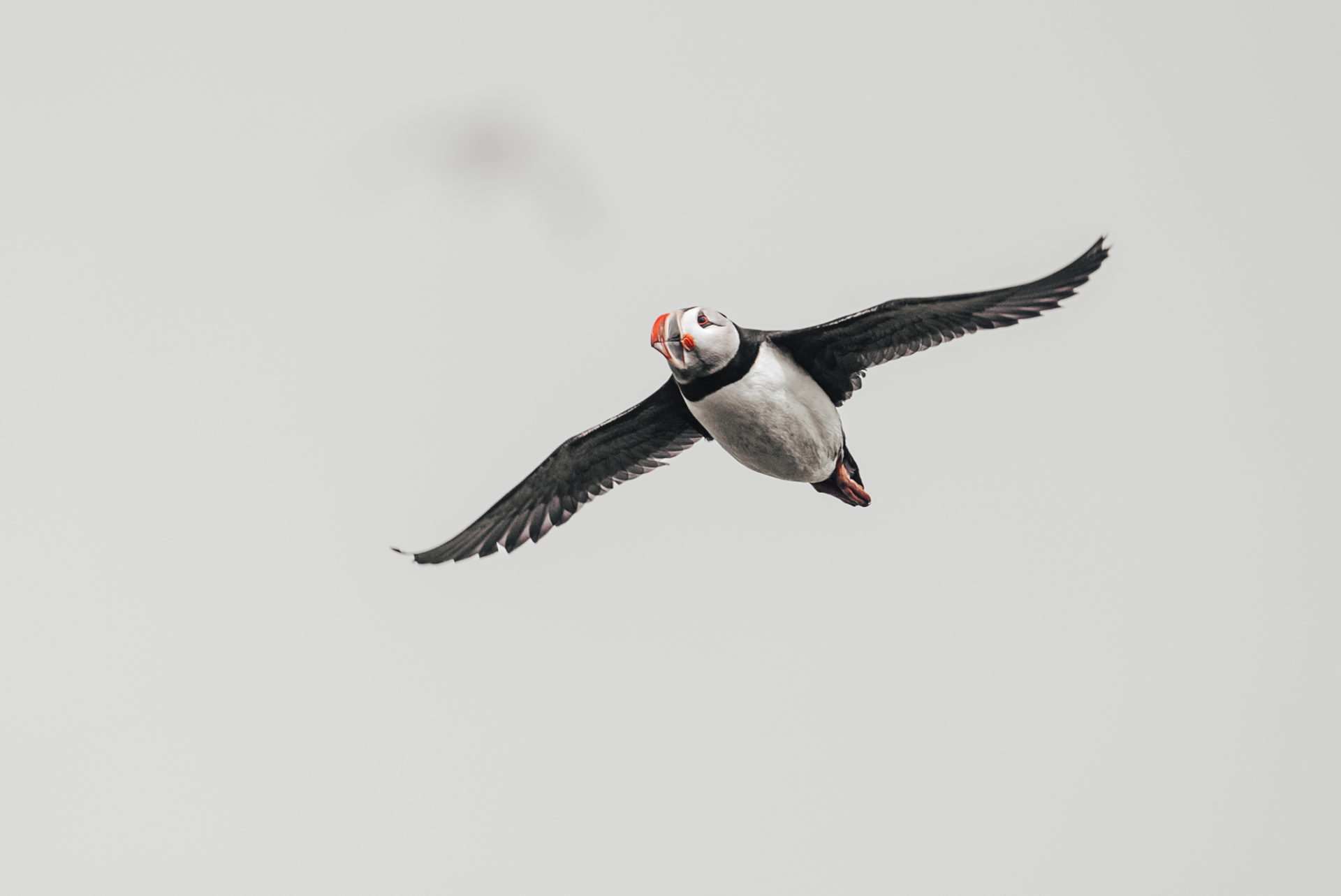
Visit Kalsoy Island
Visiting Kalsoy Island was one of the highlights of our time in the Faroe Islands. A destination that offered incredible views with a bucket full of stories.
To get to Kalsoy, we took a ferry from the port of Klaksvik to Kalloy and joined a local guide, Rani Nolsøe, for a day tour of the island. Rani grew up on Kalsoy, immersed in its myths and surrounded by its stories from early childhood.
We visited the seal woman statue in Mikladalur Village, listening to Rani’s rendition of the legend that runs deep through the veins of this town. The town
We hiked to Kallur lighthouse, passing sheep perched up on the side of the cliffs. The lighthouse itself was a bit of a letdown, but the view of the sheer cliffs overlooking the ocean was a breathtaking sight punctuated by the sunlight on yet another radiant day in the Faroes.
It was exactly here that Agent 007, was laid to rest in the latest rendition of the James Bond saga – “No Time To Die” .His tombstone from the film sits on the side of the mountain, creating yet another attraction in the area.
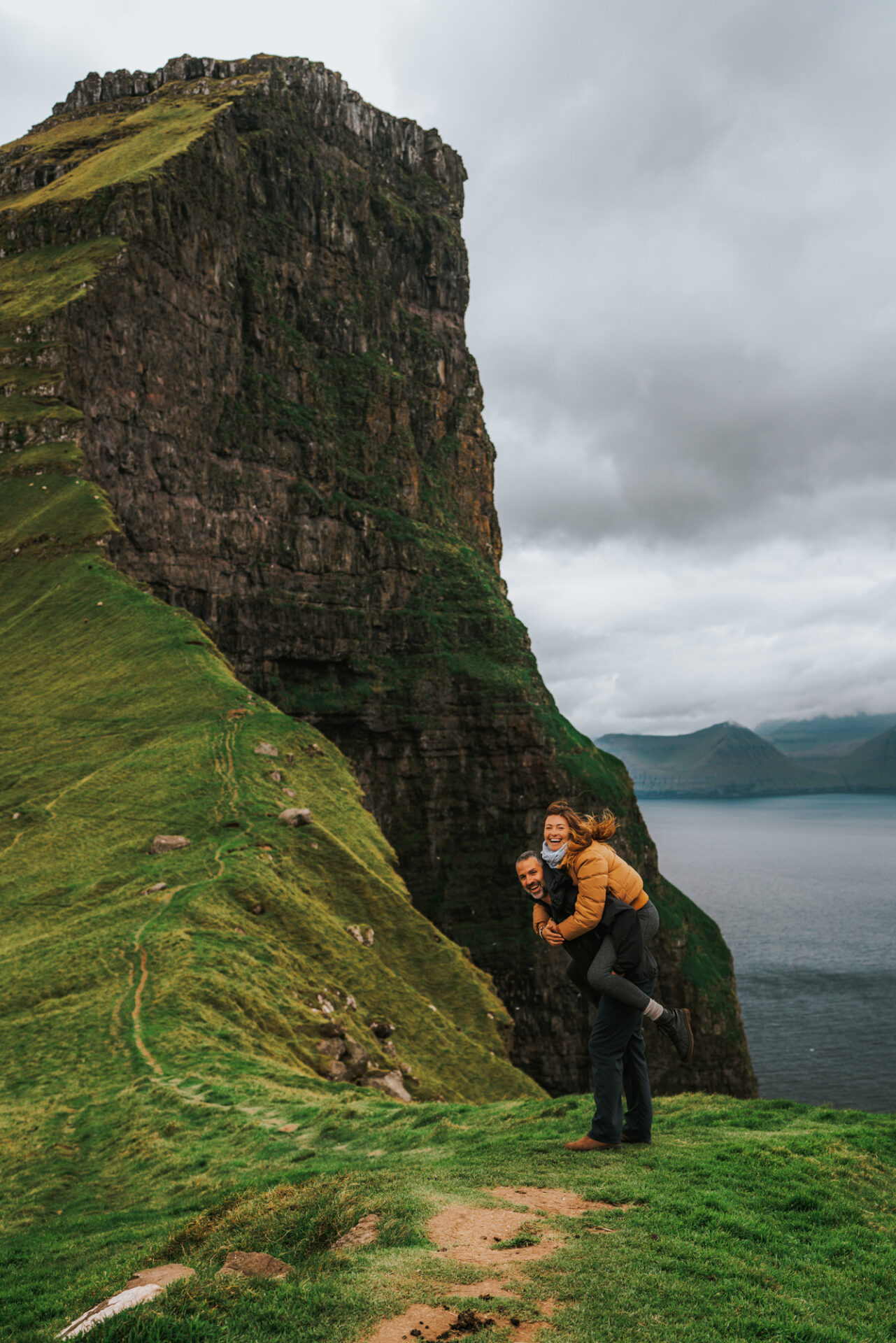
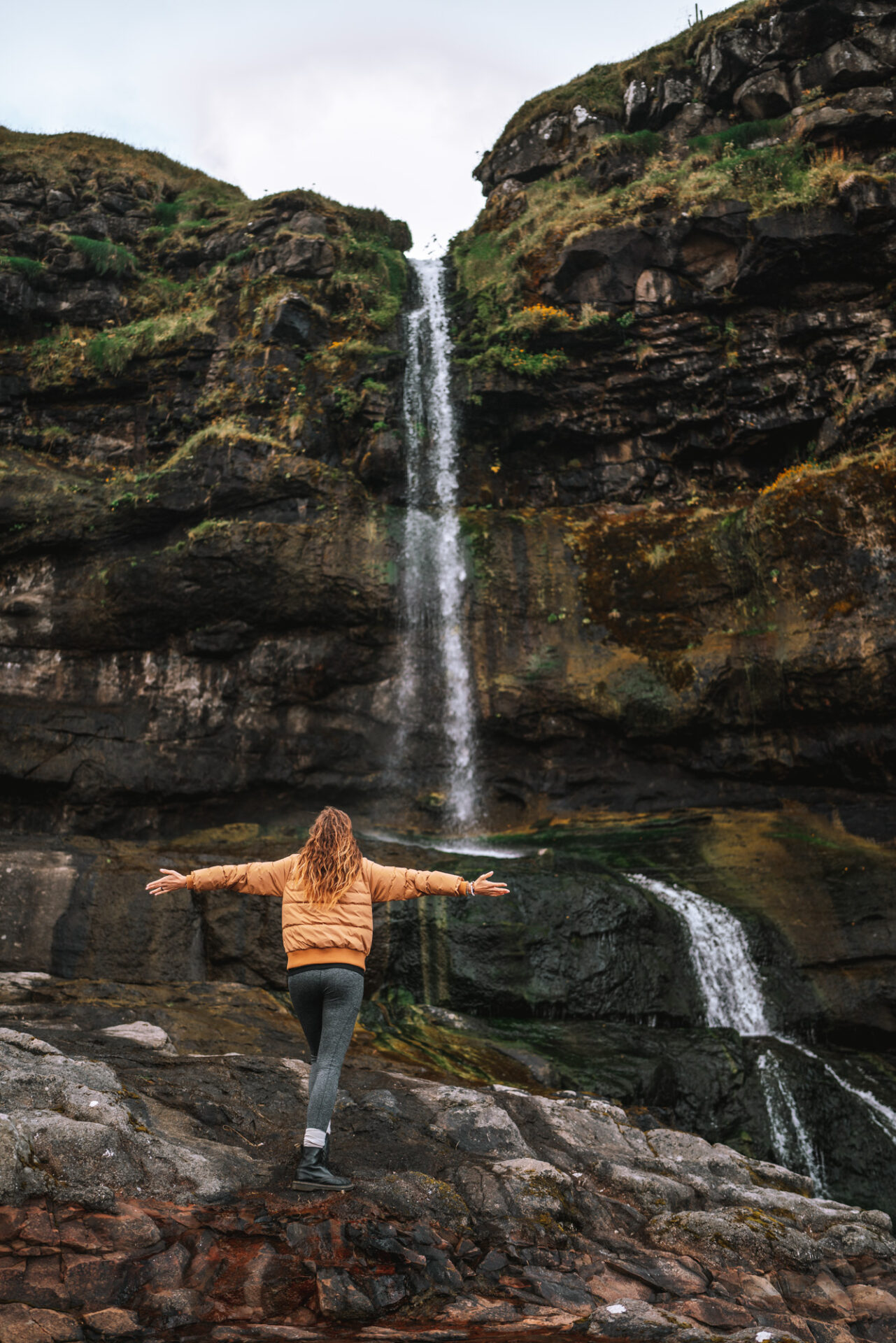

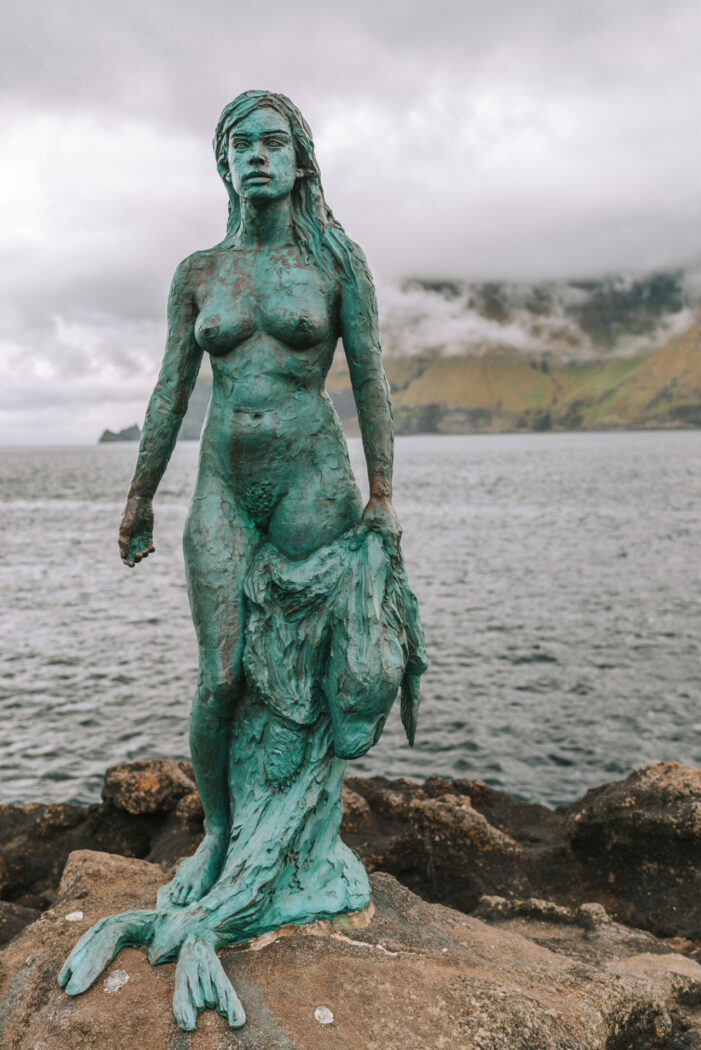
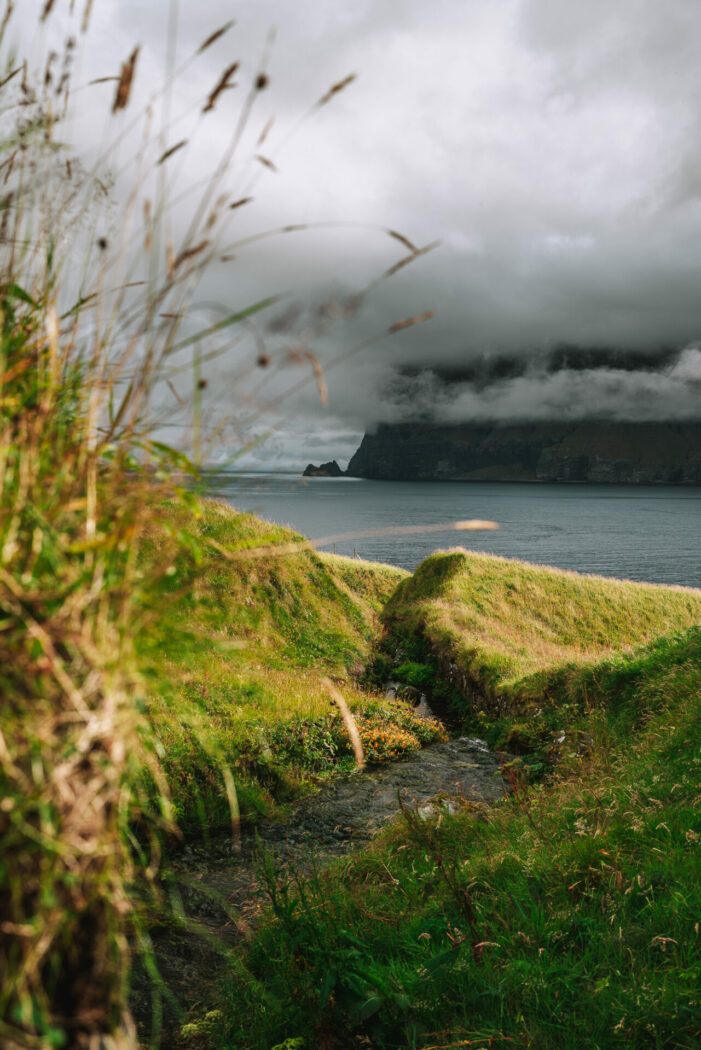
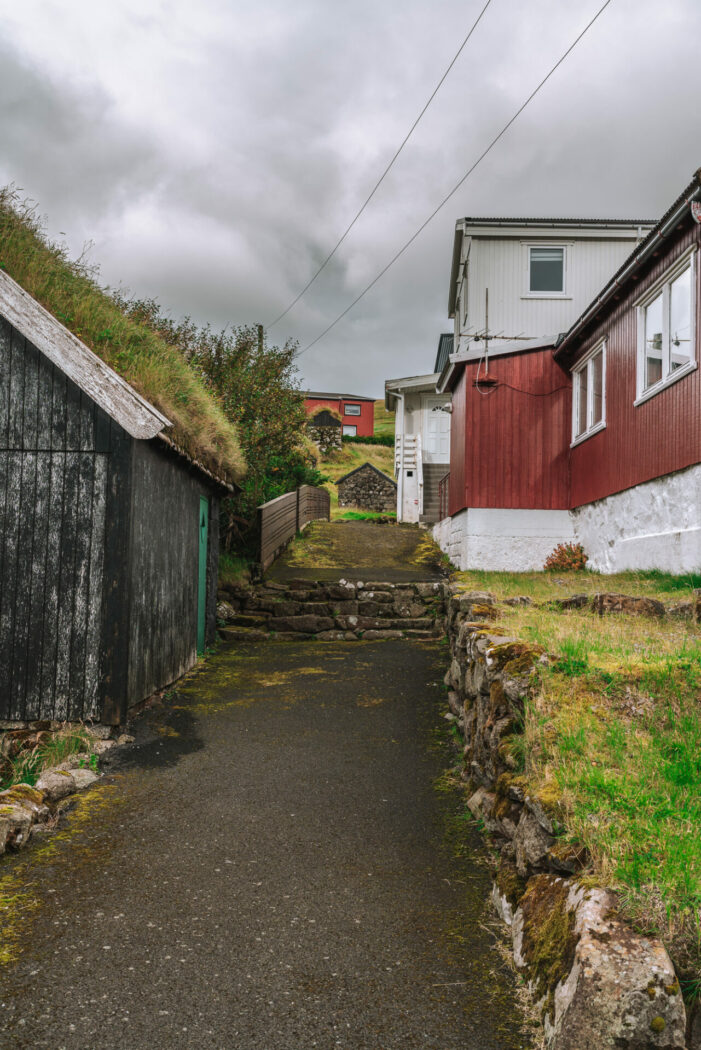
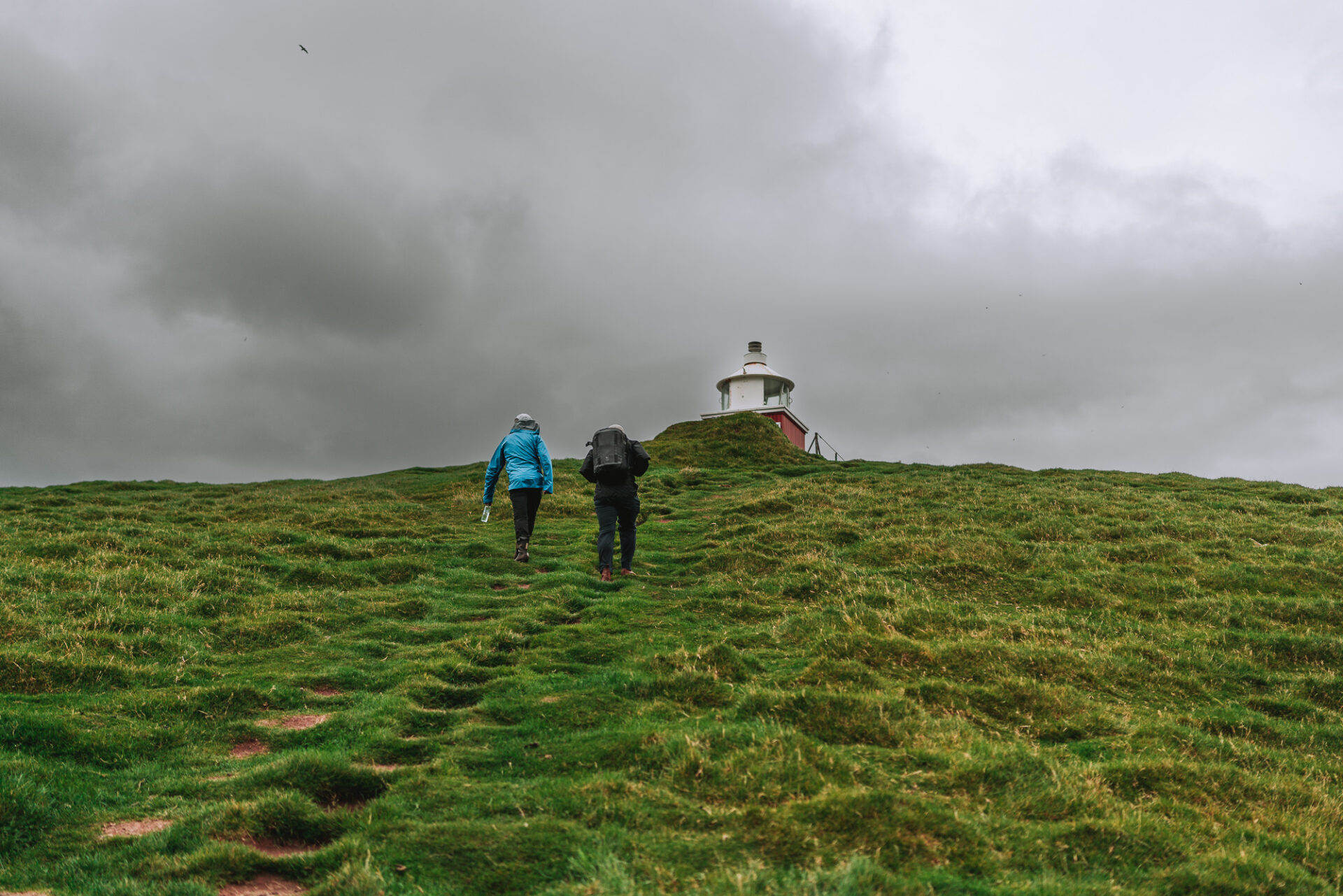
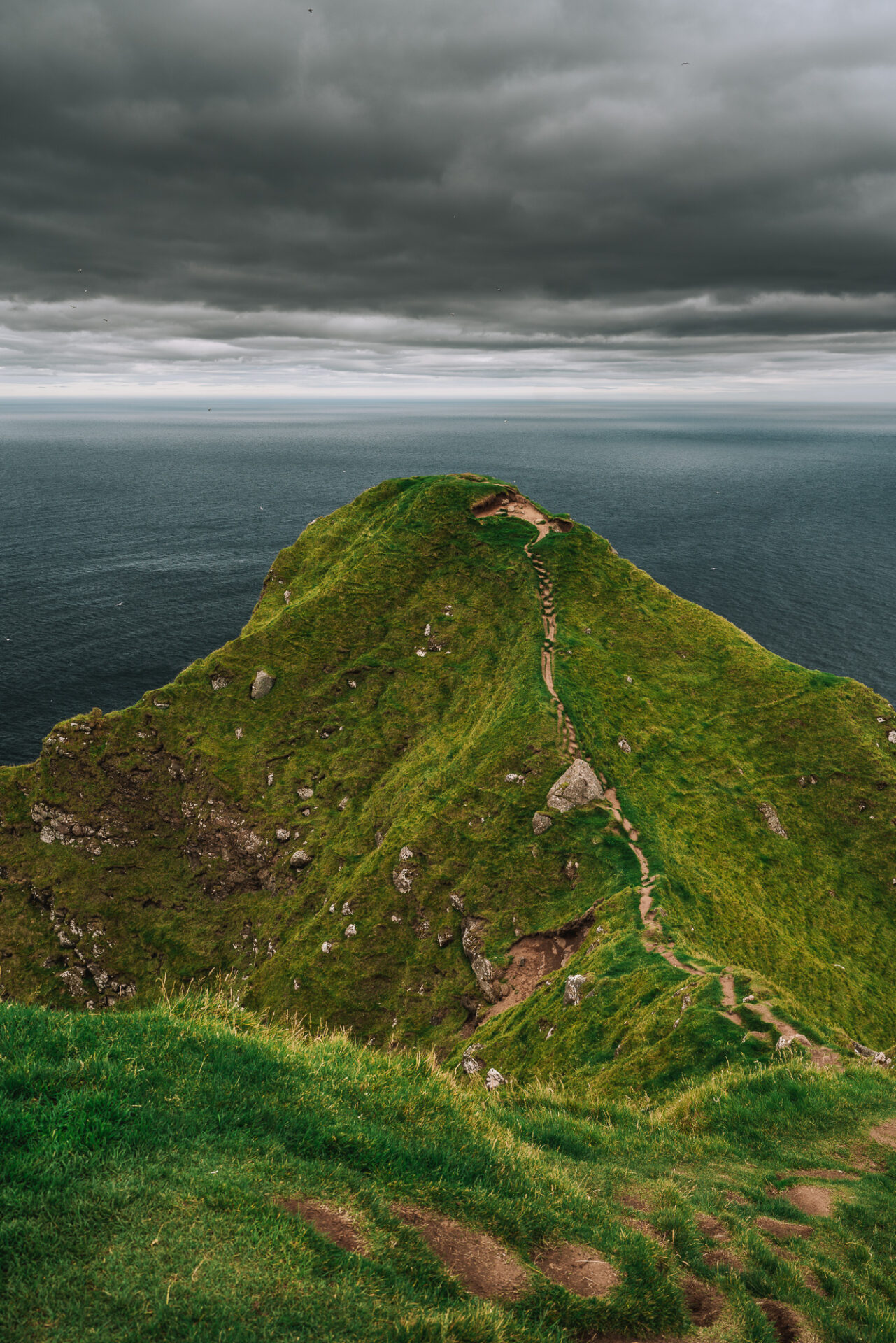
Northern Islands
The Northern Islands of Kunoy, Bordoy, and Viðoy act as the last frontier in the Faroe Islands, visited by few tourists but admired by many locals. The road through the islands features steep mountains and narrow straits, but the area’s main attraction is the scenic hiking opportunities and photo ops.
Hike to Cape Enniberg
The hike from Viðareiði to Cape Enniberg is a journey to the Faroe Islands’ northernmost point with a 754-meter drop to the sea. The views from here are meant to be spectacular, but the 3-5 hours hike is not for the fainthearted with steep cliffs and loose rocks.
Short on time? Make your way to the base of the photogenic mountain Malinsfjall and admire the views over the Northernmost islands from the village Viðareiði.
Where to Stay in Faroe Islands
Limited tourism infrastructure in the Faroe Islands means that hotels in the Faroes are not as plentiful as in other parts of the world. The capital, Torshavn, offers some of the best accommodation in the islands, but hotels can also be found outside the capital in most parts of the country, including Runavík (Eysturoy), Vágar Airport (Vágar), Klaksvík (Borðoy), Vágur (Suðuroy), and Tvøroyri (Suðuroy).
Here is where we stayed during our time in the Faroe Islands.
Hotel Føroyar, Torshavn
The newly renovated Hotel Foroyar is one of the biggest hotels in Torshavn. Perched on a hill overlooking Torshavn and the surrounding landscape, the 4-star hotel has over 200 rooms and is a popular choice for big conferences and meetings. Despite its size, it manages to effortlessly blend into the natural environment and make you feel like you are the sole guest on-premises. The turf roof on the outside matches the purposeful design inside. It’s minimalistic and moody, taking inspiration from inside of a puffin cave.
The rooms are trendy, stylish, and bright inside, with a panoramic view of the city below. We particularly loved the views from their restaurant, where a buffet breakfast included in the room rate was served every morning.
Hotel Føroyar is part of the new ‘Faroese sustainable business initiative’ with some ambitious goals. Along with their recycling initiatives, the new hotel extension and the spa area are now heated with earth energy.
Hotel Havgrím, Torshavn
Staying at Hotel Havgrim was a completely different experience. With just 14 bedrooms, the hotel is small, intimate, and family-run. Built in 1948, the house used to be the residence of the head of the Danish navy and was only recently converted into a hotel.
The design takes inspiration from the fjords, the colours are bright, influenced by the sea and sky. The rooms vary in size and layout but feature luxurious beds, en suite bathrooms and a cozy feel. If availability allows, we recommend splurging on the Commodore Suite, featuring a 180-degree panoramic window overlooking the ocean.
We were happy to see a focus on sustainable operations through the owners’ commitment to the environment. The hotel is heated by ocean thermal energy and sources its water from a depth of 200 meters. Eco-friendly products are used throughout the hotel, and locally sourced produce can be found on the breakfast buffet menu.

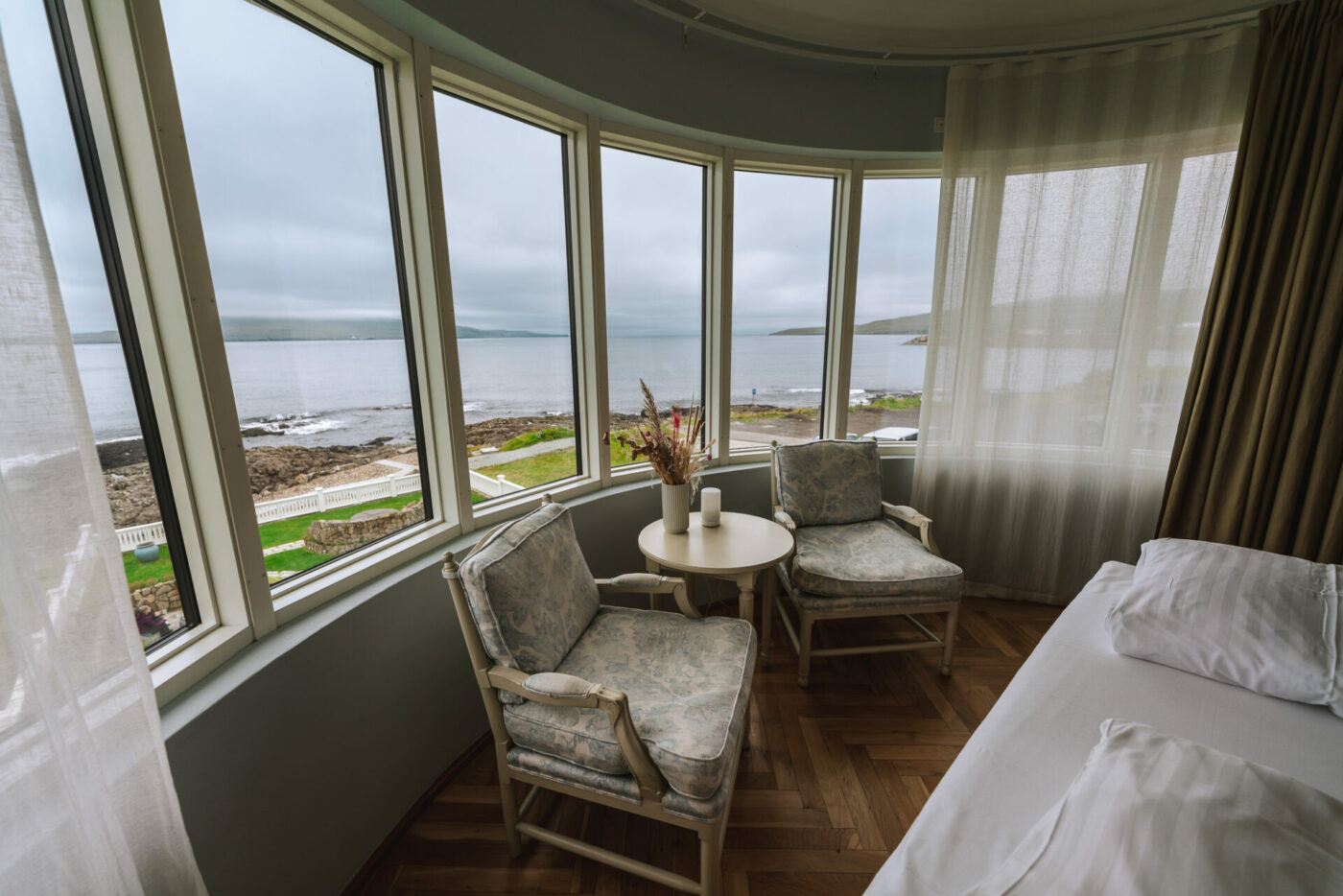
The View, Bøur, Vagar Island
The turf-roofed cottages known as “The View” offer the most traditional and unique accommodation option we stayed in during our time in the Faroes. Perched on the side of the cliff, the cottages face West, offering the most incredible views of sunset over the Tindhólmur are Gáshólmur and Skerhólmur rocks.
Built in the traditional Faroese holiday home style, the houses feature stone grounds, wide black cladding widths, and white attic windows. Each cottage has a well-equipped kitchen, bathroom, washing machine and a living room. A wooden staircase leads to the top floor, where 2 bedrooms can comfortably accommodate a family or a group of 4 friends.
The cottages are located in the village of Bøur, an old settlement with just 65 residents. The famous Mulafossur waterfall is a 4 km drive away – an ideal location for those wanting to photograph Mulafossur at sunset or sunrise. The Vágar Airport is only 6 km away.
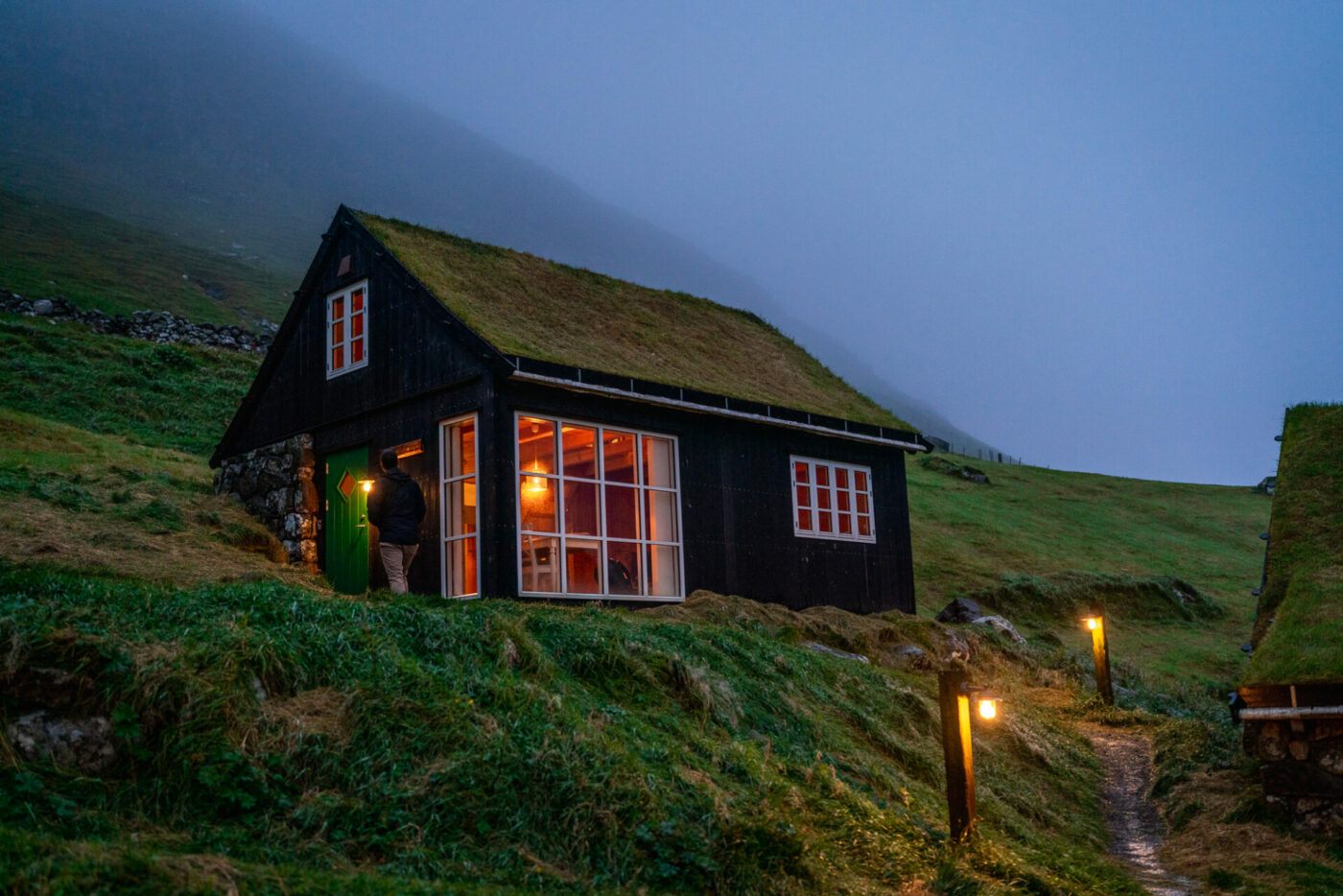

Hunasarstova Farm Stay
Æðuvík, Eysturoy Island
Harriet and John’s beautiful newly built tiny home is the B&B of dreams. The guesthouse is in Æðuvík, a small town with roughly 103 inhabitants on Eysturoy, Faroe Islands. The property is a working farm with chickens, dogs, sheep and a barn cat.
The guesthouse, designed by Kraft Architects, is stylish and functional. The ocean view is ever-changing. It’s ideally located to offer that tiny town feel while only 20 minutes away by car from Torshavn and many things to do in Faroe Islands.
Self-serve breakfast is included in the stay, and guests have the opportunity to book an incredible farm-to-table Faroes dinner with the hosts – a MUST for anyone looking for a cultural experience like no other (see things to do in Faroe Islands section above for more info).

Best Restaurants in Faroe Islands
The people of the Faroe Islands have been farming for centuries, but only in recent decades did they begin to develop their own cuisine. New restaurants are emerging all over the Faroe Islands with dishes that feature fermented meats, locally farmed salmon, and an occasional migratory seabird.
Most of the best restaurants in Faroe Islands are located in the capital city of Torshavn, with a few others dotted around the islands. Here are some of the best, tried by us or recommended by locals during our travels.
Roks
If you are only going to splurge on one expensive meal in the Faroe Islands, make the ROKS.
The sister restaurant of the Michelin-starred KOKS (currently set up in Greenland), ROKS offers a unique 5-course and 7-course tasting menu. Locally sourced ingredients mingle with creative cooking techniques to deliver unique takes on simple local ingredients like cod fish, monkfish, capelin and lobster.
Menu changes seasonality but promises to be an unforgettable meal. We certainly thought so! Bookings are essential. Open for dinner Monday-Sunday.

Barbara Fish House
This charming tapas restaurant, located inside a cute turf-roofed house, offers a journey back to 16th-century Faroese cuisine. The set menu ranges from 3 to 6 courses and features, you guessed it, fish and other seafood, freshly caught right here in the Faroe Islands. A vegan menu is on offer. Reservations are essential, and the restaurant is only open for dinner Wednesday – Saturday.
Katrina Christiansen
At Katrina Christiansen, excellent food is served in a cozy setting. Food is inspired by Spanish tapas cuisine and completed with influence from Faroese food tradition. Tapas are available on the a la carte menu, but the restaurant is also known for its popular 7-course William tasting menu and 5-course Katrina tasting menu. Every Sunday at lunchtime, the restaurant serves us a traditional Faroese Roast, with lamb, potatoes, red cabbage, green peas & gravy. The menu is delicious and very reasonably priced! A must if you find yourself in Torshavn on a Sunday.
Áarstova
This cozy wooden restaurant located in the heart of the city is undoubtedly one of the best restaurants in the Faroe Islands. Lamb and seafood are the specialties featured on their 3-course and 5-course menus. The carefully chosen wine and Scottish ales top the experience. Reservations are a must, Áarstova is only opened for dinner Tuesday-Sunday.
etika Sushi
etika, the only sushi restaurant in the Faroe Islands. The restaurant serves high-quality sushi by combining Japanese techniques with fresh Faroese fish and sparkle of creativity. The menu is diverse and features grilled fish, seafood, and locally Faroese lamb. Open for lunch and dinner daily. Walk-ins welcome.
The TARV Grillhouse
The newly opened TRV Grillhouse by Torshavn’s harbour serves an a la carte menu of grilled meats and fish, some vegetarian options, and plenty of sides. The restaurant is just next to the Vágsbotnur fish market, so the ingredients are as fresh as possible.
It’s a popular spot, so while reservations are not necessary, service can be a little bit slow.
Kafe Kasper
One of our favourite low-key cafes in Torshavn, Kafe Kasper offers a great budget-friendly menu featuring their famous bagels and budgers. Cozy atmosphere in a easy-going spot in the heart of Torshavn.
How can I prepare for my trip to the Faroe Islands?
A trip to the Faroe Islands requires a bit more planning and consideration than other destinations, as the infrastructure is not as well developed as one might expect. We recommend finalizing your itinerary and making all the bookings well ahead of your visit to ensure availability, especially if you are traveling in the summer. Book your accommodation, reserve your car, book some tours, and even make some dinner reservations!
What should I bring with me when traveling to Faroe Islands ?
No matter what time of the year you are visiting, pack for ever-changing weather. First and foremost, comfortable shoes are a must – you’ll be doing a lot of walking. A raincoat is also a good idea, as even the best-planned day can be spoiled by a sudden downpour. When it comes to clothes, it’s layers, layers, and more layers – we recommend natural fabrics that wick away moisture, like merino wool! And of course, don’t forget your camera! With its dramatic landscapes and plenty of birds, the Faroe Islands are a photographer’s dream.
How much time do I need to spend in Faroe Islands?
It really depends on what you want to see and do. If your main goal is to see Torshavn and enjoy the stunning scenery of the nearby attractions, then 5 days or so could be enough. But if you want to explore all the islands, hike to some of the best viewpoints, and maybe even island hop to some of the smaller islands, then you’ll need at least a week or 10 days. Keep in mind that poor weather conditions can wreak havoc on your plans, so it’s always good to plan for a few extra rainy days! No matter how much time you have, make sure to enjoy every minute of your stay in the Faroe Islands.


